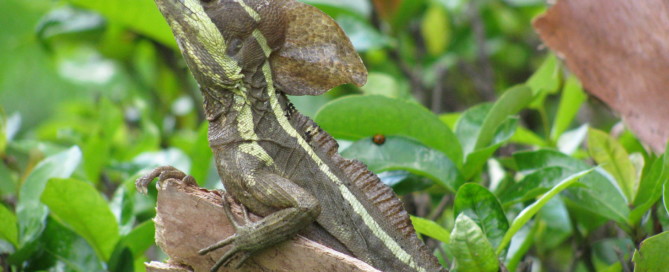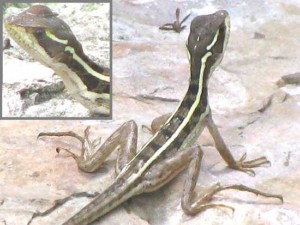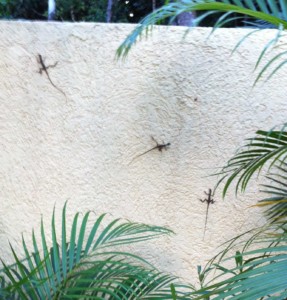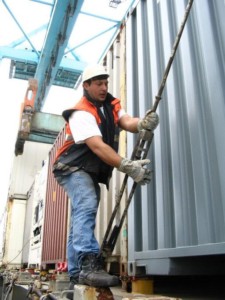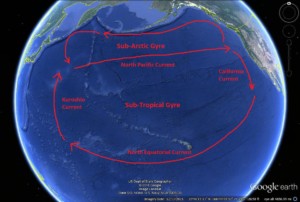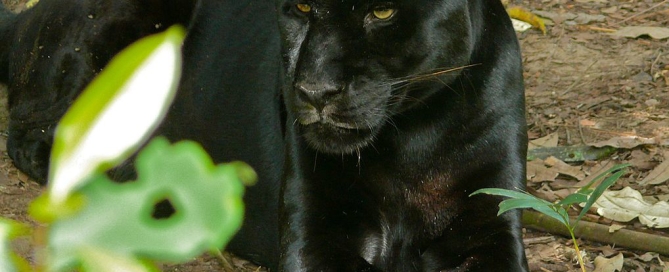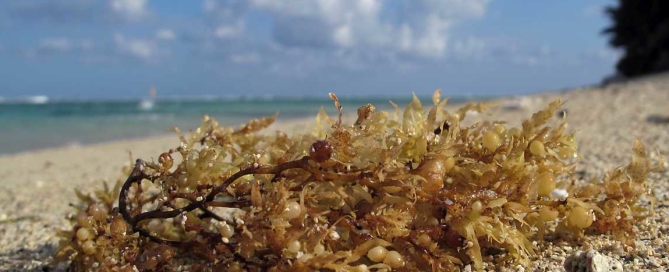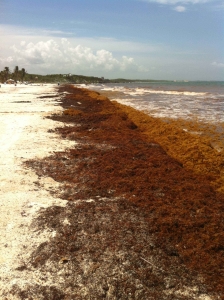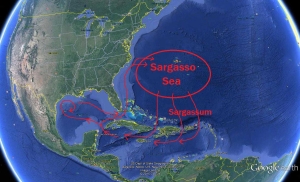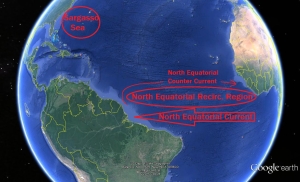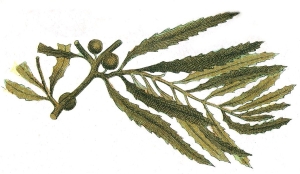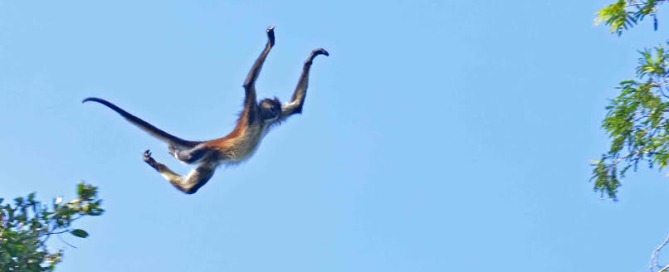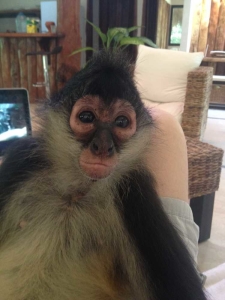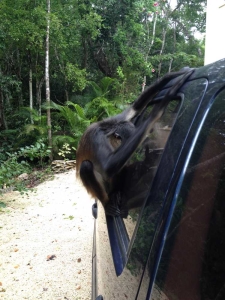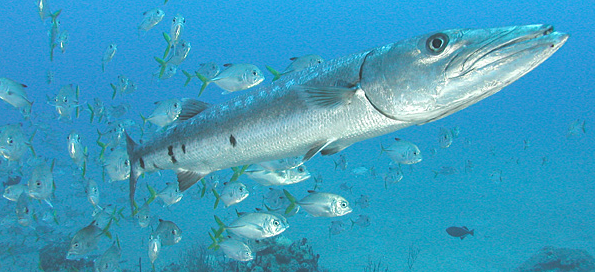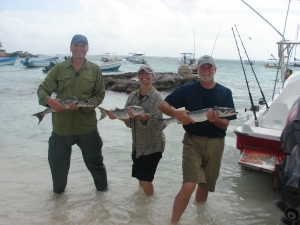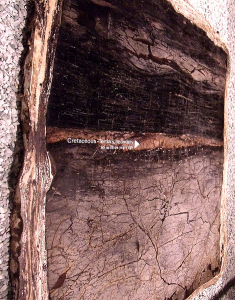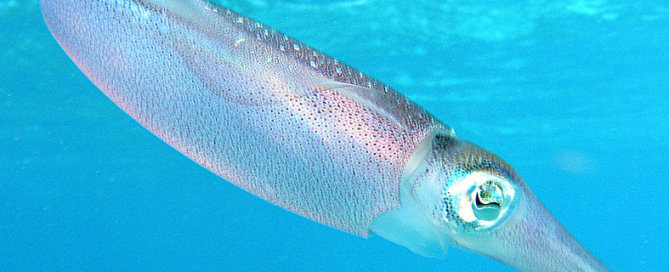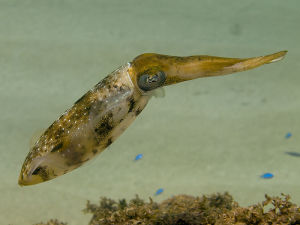The Jesus Christ Lizard
I am not a religious person, but I do believe in miracles. If a miracle can be defined as something that we cannot explain, then believe me, my life is just full of them. I was approaching our sizeable fish and lily and hyacinth and turtle and dragonfly pond yesterday when a striped basilisk (Basiliscus vittatus) saw me coming and took off running on his hind legs straight across the surface of the water to the far bank and disappeared into the jungle.
It was a miracle straight out of Matthew 14:22, but I’m not going to a biblical place with this. Miracles, in my mind, have a very real place in evolutionary science as well. If you are a prey species like the basilisk, of whom only two percent survive to the two-year mark, you need an occasional miracle. Different species have evolved different ones. The flying fish can explode through the silvery overhead “sky” that the predator fish thought was the limit of the visible universe. The Caribbean reef squid can jet out a cloud of ink and then real quick change color and shape to look just like a cloud of ink next to the cloud of ink. The horned lizard can shoot caustic blood in twin streams out of his eyes for up to four feet, with considerable accuracy. These are evolution’s miracles. They are that last trick that you keep in reserve for when you’re really in trouble. They vary, but they all have the quality that they are so startling and unexpected that they leave the predator standing there with his jaw on his chest like Wily Coyote, while the prey disappears over the horizon. Scientists call them predator evasion adaptations. I call them miracles. For the basilisk, this is what it is: He can walk on water.
But their favorite place to hang out is near water, which is why they like the banks of our fish pond. That’s where they can avail themselves of their miracle. They have flaps of skin on their toes that open when they slap the water, and provide more resistance, and also trap air, which creates just a little buoyancy. They gyrate their legs in a circular three-part move of slap, stroke, and recover, and, being lizards, their hind quarters splay outward quite a bit, so that each slap is to one side and then the other, which keeps them stable as they run. This is actually fairly important—even if you or I were capable of running on water, we would pitch over to one side or the other because our legs are both directly underneath us. The outward thrust of their gait solves that problem, and it also gives them a very comical look when they run, and I always crack up when I see it. To invoke yet another cartoon, they remind me of the Disney character Goofy when he’s in full sprint.
But it’s exhausting work running on water, and they actually can’t make it terribly far. You might not realize it, but when you trot along a street or a running trail, you’re enjoying a huge re-use of energy as the impact of each step is stored, spring-like, in the connective tissue and muscles of your leg, and then released again into the next step. When you run on water you don’t get that. With each slap and stroke, the energy is hurled down into the water and is gone. Every stroke’s a new stroke. The power you put into it has to be unflagging. The basilisk can make it about ten feet on his hind legs, then another six or so on all-fours, and then he drops into the water and swims for it. Fortunately, they are good in the water too, and can swim, and even dive.
Unfortunately, they have predators in both places.
Though they look goofy to us, charging along with their hind legs windmilling out to the sides, if you look closer there is an admirable grace and agility in their movements. I’ve seen them leap off a chest-high garden wall without hesitation, and hit the ground running. They can also use the Jesus Christ technique to run across the top of a field of brush—also a pretty cute escape trick.
But believe it or not, there is something else about the basilisk that is even more amazing than that, and few people know about it. It doesn’t have the showmanship of running across a body of water, but it puts these lizards in even more rarified company. Here’s what it is: They have the most accurate directional hearing of any vertebrate. Which is pretty impressive when you consider that there are some sixty-five thousand species of living vertebrates. The basilisks are the undisputed champs over all of them. They are superior to about 64,999 other animals in what I call the art of not running the wrong way. They can instantly and with unrivaled accuracy answer the question, which direction am I being charged from. And when you’re a two-percenter, it’s really nice not to get that one wrong.
It sounds arcane, but if you’re either a science nerd or a musician (and I’m actually both), you might want to read on and find out how they do it, because it will blow your mind.
You and I can tell, in a vague sort of way, which direction a sound is coming from, but I’ll bet you never asked yourself how exactly your brain is able to tell you that. My first hunch was that probably the sound is louder in the closer ear. That’s true, and it’s called interaural intensity difference (IID), and it’s how we humans do it, but I’ll bet you also never asked yourself why exactly the sound is fainter in the far ear, and that’s where it gets interesting. It turns out that it’s not because of the difference in distance, which is usually only a tiny fraction of the total distance to the sound source. It’s actually because of a thing called diffraction, in which the sound waves wrap around the object and lose some of their punch in the process, and here’s the thing about diffraction: It stops working as the object gets smaller, relative to the wavelength of the sound. Our heads are twenty times the diameter of a basilisk head, so IID can give us at least a hunch which way a sound is coming from, but for a basilisk it’s pretty much worthless. Their heads are just too small to create any diffraction for most wavelengths of sound. The math is fun: The rule of thumb scientists use is that the ratio of the head size to the sound wavelength needs to be greater than 0.1, and you’d be surprised how big some sound waves are. Believe it or not, middle C on your piano keyboard has a wavelength of 51 inches, which for a basilisk with a half-inch head creates a ratio of 0.0098—not even close to working. The C that is four octaves below middle C has a wavelength of 69 feet. I actually already knew this kind of stuff because back in my musician days I had to set up my gear and make it work in all manner of places, and 69 feet does not even fit in some rooms I have played, which is why the bottom end of a band’s sound is always muddy in a small club.
Another technique some organisms use is the teensy time difference between the sound hitting the near and the far ear. This is called interaural time difference, or ITD. That also doesn’t work for small animals like the basilisk, because the time difference is simply too small.
So this is where it gets really good. Here’s what they do: Both their ear canals open into the mouth, so that the sound hits one eardrum, then passes through the mouth and hits the back of the other eardrum. So the vibration of the eardrum is the result of the difference between those two sounds. If both ears are equidistant from the sound source, each wave hits the eardrum simultaneously from both sides, and the sound is dampened. If, on the other hand, the sound has travelled, let’s say, half a wavelength farther to reach one of the ears, then the waves hit the front and back of the eardrum alternately and that thing really gets to vibrating and the volume takes a giant leap. Most often it’s something between the two, and one sound will be advanced or backed off only slightly from peak-to-peak synchronicity with the other. You musicians out there, especially you aging 1970’s-era rock musicians, might remember a gadget that was popular back then called a phase shifter (they’re still around), which would split your sound in half and then do this rhythmically to one of them, so that the background ambiance would sort of swoop up and down in pitch. It’s hard to describe, but you’d recognize it if you heard it. There’s every chance that the world of the basilisk sounds a lot like a Doobie Brothers track.
But the difference between the Doobie Brothers and the basilisk is that the basilisk actually does something critical and exacting with this phase shifting data, and his life depends upon it. The calculations are both swift and precise, and he does it with multiple wavelengths simultaneously (few sounds consists of just a single pitch). Phase shifting is quite pitch-dependent, and the basilisk has the system tuned to be most effective up in the high end, which is where sibilant sounds like swishing and crunching happen—the you’re-being-jumped sounds. Many creatures use this technique. It’s called a pressure difference receiver. Some use it not to avoid each other, but to find each other, and have it tuned more for the sound of a mate. And though the basilisks are the masters of it among the vertebrates, it’s actually the insects who get insanely sophisticated with it, taking sound in through two or three different portals, some of which are not even anywhere near the head, and passing them through “acoustical trachea,” and even putting the sound through double membranes in places to further exaggerate the time delays. The result is animals like the field cricket (family gryllidae), who can be in a meadow with dozens or hundreds of crickets and other insects, but hear each one individually by “seeing” its location. They call it three-dimensional hearing, or auditory scene analysis. What it does is it eliminates sound masking. Because they hear not just a sound, but also a spatial location, they can choose which sound they listen to, just like you and I can choose which object to look at. You and I just hear a big racket in that meadow, but to a cricket, those myriad insect sounds don’t mask each other any more than one painting on a wall masks the one next to it.
Now you know.
Sources:
http://www.backyardnature.net/mexnat/basilisk.htm
http://www.acoustics.org/press/154th/carr.html
http://news.nationalgeographic.com/news/2004/11/1116_041116_jesus_lizard.html
http://www.ncbi.nlm.nih.gov/pmc/articles/PMC4282874
http://www.ncbi.nlm.nih.gov/pmc/articles/PMC2580811
http://www.phy.mtu.edu/~suits/notefreqs.html
Tennis Shoes and Ocean Gyres
The container ship Hansa Carrier was having a rough time of it.
It was oh-dark-hundred on May 27th, 1990, and she was in the middle of the cold, cold waters of the North Pacific, 500 miles south of Alaska and still 1,700 out from her destination of Seattle, Washington. For a 527-foot ship, she was getting pretty badly beaten, pummeled by monstrous swell, and rolling heavily. In those days container ships got weather updates customized to their routes every twelve hours, but stuff in the North Pacific happens way faster than that. If she was like most container ships (we don’t have a lot of information on this), the boxcar-sized containers were stacked up to eight high above decks, which creates a blank vertical wall eighty feet tall, presented without any contouring or nuancing to whatever the ocean has for you. You’re a giant target for both wind and swell, and the swell in that area hits thirty and forty feet all the time.
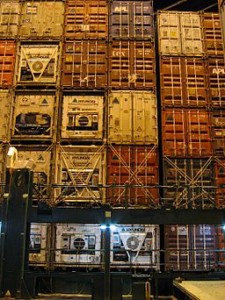
A Solid Wall of Shipping Containers By Danny Cornelissen (http://www.portpictures.nl) [Attribution], via Wikimedia Commons
Those things could have hit the water doing 62 miles per hour.
Anyway, for whatever reason, they ruptured and spilled their contents.
And so, in the greatest windfall of free data in the history of oceanography, 61,820 ID-numbered Nike sneakers hit the water simultaneously at a known place and time.
* * *
This was the heyday of the high-priced sneaker, and the press was full of stories about inner-city kids spending small fortunes on tennis shoes, so when these fairly precious things started washing up all over the coasts of Washington, Oregon and British Columbia, it created quite a sensation. No one had known they were coming, because manufacturers and shipping companies keep their container losses fairly quiet. It’s estimated that ten thousand containers go in the drink each year, and the companies just file their insurance claims and go on with life. The Monterey Bay Aquarium Research Institute (MBARI) is even doing a study about what all those containers might be doing to the marine ecosystems on the ocean floor. They presumably are concentrated under the shipping lanes, where they may be creating stepping-stone pathways for sessile (attached) organisms to make inroads into sandy sea floor habitats where they have never been before.
The beachcomber community in Oregon and Washington is quite well-developed, because those coastlines are touched by the North Pacific Current, which barrels eastward all the way from Asia, hits the northwest coast of the US and turns both north and south, creating a gigantic gyre below called the Subtropical Gyre, and a slightly less gigantic gyre above called the Subarctic Gyre. This brings all manner of fun stuff from extremely exotic lands to the beaches of Oregon, Washington and British Columbia, and makes the region one of the beachcombing capitals of the world. It took the shoes nine months to hit the coast, though no one could have predicted that at the time, because little was known about the North Pacific gyres at the time. That was about to change.
This was before the days of the internet, if you can remember that far back, but word went out by various archaic means, and the scramble was on. The shoes were in remarkably good shape. They float sole-up, with the uppers protected under water from sun and bird pecking, so once they were cleaned and scraped a little bit, you had a perfectly good hundred-dollar tennis shoe, but there was a problem—you only had one. Within the shoe boxes, which disintegrated quickly, the two shoes were not attached to each other, so they all hit the beaches un-mated. Swap meets sprang up all over the place, and people gleefully traded back and forth to get a right and a left of the same size. The press was having great fun with it, and articles headlined by bad puns were hitting newspapers up and down the coast (Soles Lost at Sea, etc., etc.) One of them was read by an elderly lady named Mrs. Ebbesmeyer. Her son Curtis was an oceanographer, and she was his article-clipping service, always snipping out newspaper stories she thought he’d be interested in (I had one of those mothers too). When she showed him this one, it got his attention.
Curtis Ebbesmeyer studies ocean currents, and studying ocean currents can be pricey research. They usually use “determinate drift markers,” and those are usually one of two things: Either a satellite-tagged drift buoy that broadcasts its location daily, which is really expensive, or an MIB—message in a bottle. It’s true, oceanographers really do use these. They’ll have a slip of paper in them asking for the finder to call or write with its date and location. Even these are not cheap to deploy. The bottles aren’t free, and you have to stuff the slips of paper into all of them, and then create a good, solid seal of some kind, and then you have to hire a vessel, or rent, borrow or beg space on one, to get them into the water where you want them. It’s unusual for anyone to deploy more than one or two thousand of these, and the rate of callbacks you get is only one or two percent, so even a couple thousand of them doesn’t net you that many data points. When Curtis dutifully read the article his dear old mom had clipped out for him, his eyes lit up. He realized something no one else had realized: This was scientific gold.
He started making calls, and haunting the swap meets. The case finally broke for him when he met a starving artist in Cannon Beach, Oregon, named Steve McLeod, who was an addicted beachcomber. Steve had set himself up as a mail-order matchmaker for unrequited sneakers. He was getting some pocket money by selling them for thirty bucks a pop, but the really cool thing about him is that he kept records. He had the dates and locations of over 1,600 sneaker strandings. Curtis loved this guy. Now he had some data in hand. He decided to call an old friend at the National Oceanic and Atmospheric Administration (NOAA).
* * * *
Jim Ingraham was an oceanographer like his friend Curtis, but he was also a computer guy, and years ago he’d worked up some modeling software that has come to be called the Ocean Surface Currents Simulator, or OSCURS. It was only for investigating the migration of salmon (he worked for Alaska’s Fisheries Bureau at the time), and they’d never really had a ton of data with which to perfect it or explore new uses. But it seemed to Curtis that they should be able to use this thing. He reasoned that Jim should in theory be able to subtract out the swimming speed of the salmon and have a model that would work for passive drifters, like bottles, or sneakers. He ran it by him, and suggested a blind test, giving him only the date and location of the spill, and asking him to predict first landfall. How long did Jim think it might take to make the software modification? “I’ll fax the results to you in an hour,” Jim said.
Jim did pretty well. He predicted Washington in December and January and Vancouver Island in January-February. Vancouver Island had actually been first, but hey—they seemed to have a pretty good current modeler on their hands. Previously they’d only been able to test it using a single three-month trip by a satellite drift buoy. Now they could use the data from thousands of drifters—and over multiple years! They went to work, Jim on his software, and Curtis on his networking and data collecting. He was getting the beachcombing community pretty wired, making appearances here and there, and getting his name known so people would call him with data. He called the shipping company and got stonewalled, but Nike was wonderful and greeted him with open arms, opening their records for him, which were very detailed. They had the info on every sneaker by the purchase order number that was stamped into it, right down to which container it had gone into—which is why we know that one of Nike’s five containers did not break open.
Jim and OSCURS correctly predicted Northern California for 1992, and, a year later, Hawaii. Then he predicted Japan for 1994. Curtis went on Japanese television wearing pink Nikes, but he got no calls—there would be no further landfall until the next revolution of the gyre. Then the sneakers started hitting the northwest coasts again, and Jim and Curtis now had the orbital period of the Subarctic Gyre. Turns out it averages 2.9 years, for a travel rate of 6.9 miles per day. We hadn’t known that. You can thank the sneakers.
But things were about to get even more interesting. Because on January 10, 1992, another container ship named the Ever Laurel was having a rough time of it…
* * * *
When a container ship is travelling through following or opposing seas—that is, the swells are coming either from straight in front or from straight behind—an odd thing can happen called parametric rolling, and it’s hair-raising. Most descriptions of it get mathematical, but it’s so fascinating that I decided to challenge my descriptive skills and give this a shot for you. Large ships, and especially container ships, are narrow in the bow and stern for obvious streamlining reasons, but they don’t like to part with all that deck space up above, so above the water line the hull typically flares dramatically outward again and becomes much wider at the deck level. So there are these big shoulders sticking out to the sides above the bow and stern, supporting a wide deck, and they’re normally above water line, but if they do plunge into the water they are, of course, quite buoyant. So picture a ship rolling to one side twenty-five or thirty degrees (yeah, that happens all the time). It plunges that huge shoulder into a swell, and gets shoved back upright by that extremely powerful buoyancy, which is called its “righting force,” and the ship is sent rolling with great momentum over to the other side, but when it gets there—there is only air. That’s because the swell has moved on, and is now amidships, and the shoulder is just dropping and dropping into a trough. It continues to plunge, until finally the next swell comes up under it, and shoves the ship back the other way again, this time with even more force, because this time the righting force starts lower down and has more travel—and then the process repeats itself again on the first side.

An Empty Container Ship, displaying bow and stern flare, and bridge wings By user:Nico-dk / Nils Jepsen (Own work (own photo)) CC BY-SA 2.5, via Wikimedia Commons
If the harmonics are just right, it can be a self-amplifying process leading all the way to capsize. We don’t know if this contributed to what the Ever Laurel was experiencing, but we do know that she was in forty-foot swell, rolling up to 35 degrees, and that at times the bridge wings dipped into the seas. Finally, two columns of containers nearest the pilot house gave it up and burst their lashings, and twelve containers plunged into the ocean.
And so, in the second-biggest windfall of free data in the history of oceanography, 28,800 rubber duckies hit the ocean at a known place and time. I’m not making this up.
* * * *
To be accurate, only a quarter of them were duckies. The rest were actually beavers, turtles and frogs, all bathtub toys called Friendly Floatees, made by a company called The First Years, Inc. Unlike most rubber duckies, these had no squeaker or other hole in them, so they were completely sealed. These were very seaworthy rubber duckies. They were designed to withstand 52 dishwasher cycles. But they were destined for a greatness far beyond that.

A loaded container ship, with stacks eight high abovedecks. By Huhu Uet (Own work) [GFDL or CC BY 3.0, via Wikimedia Commons
Jim and OSCURS predicted Washington state for the rubber duckies in1996, and then, correctly, that some would head back north to Alaska, west all the way to Japan, back to Alaska again, and then—here’s the good part—up through the Bering Straits and into the Arctic pack ice, where it would take them five to six years to cross the pole embedded in the ice, before they were released with the melt water into the North Atlantic. Sure enough, in July 2003, a duck was sighted in Maine, though we can’t know for sure whether it was one of these pilgrims since we don’t have the duck—the couple who found it assumed that a child playing nearby had lost it and would shortly return for it, so they left it where it was. In August of the same year, a frog was reported in Scotland, but again, it is lost to history. They have also turned up in such far-flung places as Indonesia, Australia and the west coast of South America. Their journeys have been absolutely epic. Even more so than the sneakers, they captured the world’s imagination. Children’s books have been written about these rubber duckies. But for Curtis and Jim’s part, they were learning volumes about the ocean’s currents and gyres, especially the two gyres in the north Pacific. Curtis was starting to understand and describe (and publish) how a gyre is not a single wheel, but a very complex system involving both wheels turning within wheels at slightly different speeds, and also wheels counter-rotating against wheels like a giant system of gears. He started describing how different pieces of flotsam will take very different paths through it all.
Other spills came along with other lessons. They discovered that right-handed hockey gloves take a completely different path through the gyres than left-handed ones, and Curtis started to investigate how the ocean sorts things by handedness. Scientists had had an inkling about this—it’s actually a trick used by organisms like the by-the-wind sailor (Velella velella), a little surface drifter which occurs in right-handed and left-handed versions, each with its tiny sail cocked at a different angle so that the prevailing winds take half the population one way and half another, dispersing them more widely and ensuring that the entire population never strands and dies in a single weather event. It also explained why a clam in the Gulf of Mexico called the elegant Venus clam (Pitar dione), which has a right- and left-handed version created by a row of spines, will occur at the two ends of a crescent-shaped bay with eighty-plus percent of the rights at one end and eighty-plus percent of the lefts at the other.

Drawing of Pitar dione by Linnaeus in his Fundamenta Testaceologiae, 1771. His scandalous descriptors: a: vulva; d: labia; e: hymen; f: nates; g: anus. Carl von Linné [Public domain], via Wikimedia Commons
* * * *
Curtis and Jim went on to track other accidental drifters, everything from derelict ships to coffins and body parts. You may not know this, but the most common body part to wash up on a beach is a foot—wearing a tennis shoe. When the rest of the body has been “disarticulated” back into the ecosystem there on the ocean floor, it is the tennis shoe that floats the foot up to the surface, where, as we’ve discussed, it drifts sole-up, protected from the ocean’s ravages. Curtis and Jim have helped forensics people investigate murders, and identify the points of origin of drowning victims and suicides.
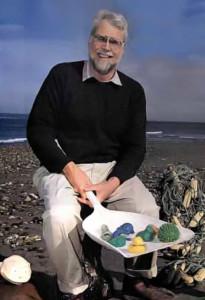
Curtis Ebbesmeyer with his scientific instruments. By Rick Rickman (http://vos.noaa.gov/MWL/dec2001.pdf) [Public domain], via Wikimedia Commons
It is mostly plastics.
That’s my next article. Now you know.
Sources:
Flotsametrics and the Floating World, by Curtis Ebbesmeyer
Moby Duck, by Donovan Hohn
http://www.csmonitor.com/2003/0731/p01s04-woeu.html
http://www.oscar.noaa.gov/
http://oceanmotion.org/html/background/wind-driven-surface.htm
http://oceanmotion.org/html/resources/oscar.htm
http://seawifs.gsfc.nasa.gov/OCEAN_PLANET/HTML/oceanography_currents_2.html
http://web.vims.edu/nmea/docs/NIKE-CURRENT_new.pdf
http://oceanmotion.org/html/gatheringdata/flotsam.htm
http://www2.gi.alaska.edu/ScienceForum/ASF10/1099.html
http://beachcombersalert.org/
https://www.washington.edu/alumni/columns/march09/alum_sneakers.html
http://www.afsc.noaa.gov/REFM/docs/oscurs/get_to_know.htm
Black Jaguars and Colored Marbles
There is a gene knocking around in jaguars that turns about six percent of them completely black. You may have known this. People call them black panthers, but they’re really jaguars with a genetic condition called melanism, which is sort of the opposite of albinism. I stumbled across this while writing my recent article about jaguars. I spared you the digression at the time, though I don’t know why—it’s not normally my nature to spare my readers a hairpin turn. Anyway, I set it aside, but a couple of things had gotten my attention about it, and months later they were still bugging me, so I finally gave up on myself and started reading again.
One thing that I couldn’t let go of is that a jaguar’s coat is yellow with black rosettes. Going from that to solid black is an extremely radical change in coloration, and evolution cares a lot about coloration, especially in ambush predators. Think about it: that jaguar spent tens of thousands of years carefully evolving a coloration that is perfect for the dappled sunlight of a tropical jungle—and then one pops out who is solid black? Are you kidding me? Why didn’t evolution, which had gone to all the trouble of creating a coat that is perfect for what the jaguar does, immediately select against this trait, and consign it to genetic oblivion? Why haven’t black jaguars disappeared?
And the other thing that bugged me was the six percent number. That’s a big number. It may sound smallish, but the mutation rate in large American cats is only a few hundredths of a percent per gene per generation. Black jaguars haven’t just avoided oblivion, they’re downright thriving. They’re being selected for. I wanted to know why. The first several places I looked casually told me the same thing: “It confers an advantage,” they said. Okay, I said. Okay.
Then why aren’t all jaguars black??
* * * *
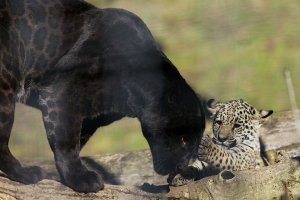
-
Melanistic jaguar and normal cub. Sometimes you can still make out the rosettes. By MatthiasKabel GFDL or CC BY-SA 2.5-2.0-1.0, via Wikimedia Commons
Circular questioning is an occupational hazard for me, and the centrifugal force that finally blew me out of this particular loop is a delightful and fascinating topic called polymorphism. The reason polymorphism exists is that genetic drift exists, and to understand genetic drift what you need to do is go to your closet and grab your big jar of blue marbles and your big jar of red marbles. Go ahead, I’ll wait. We’re going to do an exercise, and it’s not about biology, it’s about random number theory.
Put both big jars of marbles on the table in front of you. Then put a bowl in front of them and label it “Generation 1.” Into that bowl, put 10 red marbles and 10 blue marbles from the big jars. Mix them up. Now put another bowl next to it and label it “Generation 2.” Close your eyes and grab a marble from bowl 1. Note its color, then put it back. If it was red, take a red marble from the big jar of red marbles and put it in bowl 2. If it was blue, do the same with a blue one. Do this twenty times.
When you’re done, you might have 10 red and 10 blue marbles in the bowl labeled Generation 2, but you’re more likely to have 8 or 9 of one and 11 or 12 of the other, because that’s the nature of random numbers. In the short term there is variance. In the long term there is not, which is why the casinos always fleece you in the end, but in the short term things sort of jump around a lot and are uneven and unpredictable. Now repeat the process, creating a Generation 3 by looking at the marbles in the Generation 2 bowl. This time, if you had, say, only 8 blue marbles in Generation 2, the odds will not be 50-50 anymore, they’ll be stacked at 60-40 in favor of the reds, so odds are that the number of blue marbles will decrease again in the next generation, and then those odds become worse yet. Finally—and it may only take a handful of generations—one trait disappears, and is lost forever. That’s genetic drift. Even if natural selection absolutely, positively does not give a hoot whether you are red or blue, one of the traits will drift out of existence, just for mathematical reasons.
That’s what I thought should have happened to black jaguars. If their numbers weren’t sent to zero, they should have at least drifted there—or at least down to the mutation rate, which is as close as you get to zero in these affairs. Either that, or they should have fixated, which is the scientific term for becoming the new normal and going to 100 percent. Black jaguars have done neither. Their numbers are staying pegged at a fraction—a fairly sizeable fraction—of the population. What gives?
* * * *
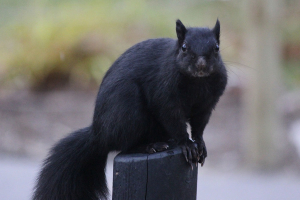
-
It’s not just jaguars: A melanistic eastern gray squirrel (Sciurus carolinensis). By Marc Steensma, CC BY-SA 3.0, via Wikimedia Commons
Evolution is delightful stuff. At its heart it is so simple that a three-year-old can understand it. Take two lumps of matter and give one of them the ability to replicate itself, and guess which one you’ll have more of in a little while? Down at its core, evolution is that stupid-simple. (And by the way, you’ll notice that nothing about that description requires oxygen, carbon, liquid water, an atmosphere or moderate temperatures—that’s just how things ended up on this planet.) But simple though the principles may be, in the course of the evolution of, say, 8.7 million species plus or minus 1.3 million, which is the current estimate of species on this planet—well, odd things can happen. One of them is polymorphism.
It turns out that black jaguars do indeed have an advantage, but it’s not because they’re black, it’s because they’re weird. They’re not what the prey are looking for. The prey are looking for a yellow animal with black rosettes. So this works for them, and evolution selects for it, and they do better than their neighboring, normally-colored jaguars—until they become too numerous and the prey start to wise up. Then they don’t have the advantage of being non-typical anymore, and the normal jaguars start to out-perform them again, because they actually do have the superior coloration for the job. So evolutionary forces are acting to keep both forms in existence. That’s polymorphism. It acts to keep the black form in existence because it’s an extremely cute trick when no one’s expecting it, but the same forces keep black jaguars from fixating, because black jaguars are actually a little easier to spot if you know what you’re looking for.
There is a swallowtail butterfly in Africa called Papilio dardanus (with the delightful common name of the flying handkerchief) that has fourteen different polymorphic forms. For almost a century scientists thought they were all separate species. In this case it is mimicry—they are mimicking various toxic species of the Danainae family of butterflies, which is the monarchs, so that the predators will leave them alone (it’s called Batesian mimicry). It works until they become too numerous and the predators start figuring it out, and then evolution will start favoring a different, more obscure form. In the end, natural selection has ended up keeping fourteen different morphs in play, all in numbers that hover just below that critical level of commonness where the predators wise up. And here’s a fun aside: only the females have all these forms. Evolution doesn’t seem to care as much about the males (I’m always feeling a little like a second-class citizen when I research evolution), so the males look more or less the same throughout their range. And what’s even more fun is that some of those female forms don’t mimic other species, they mimic the males of their own species. I’m not making this up. Scientists think it’s to keep the males from accosting them constantly to mate with them. It turns out that the battle of the sexes was not invented by us—the males and females of these butterflies have a profound difference of opinion about when and how often they should have sex, and the battle lines are genetically encoded and enforced by evolution. The male might stand the best chance of getting his genes into the next generation by mating with the female single-mindedly and repeatedly, but the female’s health gets a little bit threatened by all that pummeling, so evolution has favored a more chaste attitude on her part. The result is opposing evolutionary forces—and opposing sexual attitudes—in the same species. Evolutionary scientists call it sexual conflict.
Polymorphism goes on in our own bodies. Did you ever ask yourself why the sickle-cell anemia gene still exists? It has a habit of killing its carrier, so you’d think it would have been un-selected into oblivion, but the reason it hasn’t is that it also gives the owner a resistance to malaria, and while sickle cell anemia is pretty nasty, malaria can be absolutely devastating to populations of folks in the tropics. Besides, you only get sick from sickle cell if you’re unlucky enough to get the gene from both parents, while the resistance to malaria is yours regardless. Again, there are opposing selection forces at work for and against the same gene. Malaria won.

-
The Broad Street Pump in London, with its famous missing handle. By Justin Cormack, CC Share-Alike Generic 2.0
Cystic fibrosis is a devastating genetic disease that has touched my family personally, and the reason that gene is still around is that it also gives its owner a resistance to cholera, and cholera killed tens of millions of people in Europe from the time we started to build cities right up until 1854, which is when Dr. John Snow demonstrated that it was all about contaminated water, and he’s a pretty good yarn too. He investigated an outbreak in London by walking from door to door interviewing families of victims and putting dots on a map. He narrowed it down to a well on Broad Street, and convinced the city council to remove its handle. By that single famous act of removing the handle of the Broad Street pump, he changed history, launching the creation of urban sanitation systems, and, while he was at it, inventing modern epidemiology. That shoe-leather process of putting pins in a map is how it’s still done to this day. Now that chlorinated water supplies have largely wiped out cholera in the developed world, some scientists think (there is argument, of course) that the gene is now purely detrimental and is probably being pressured out, but these things take time when your generations are twenty years long.
Polymorphism is the reason we have blood types. You would think that the type with the best survival rate would have long ago prevailed, but it’s way more complicated than that, and in fact, we are nowhere near to a full understanding of the polymorphism of blood types, and why four different ones have been kept in play, but it’s undoubtedly about disease, and also about geography. For example, type A people are more susceptible to smallpox, type O people are more susceptible to bubonic plague, and in China, India and Russia, where there have been epic pandemics of both those diseases, there are a whole lot of type B people around.
So that’s the story on polymorphism, with only a couple of short detours into epidemiology and random number theory. Nature just loves diversity, that’s all there is to it, and this is just one way that it is constantly acting to keep us all different. As the sixties band Savoy Brown said an extremely long time ago, “Now wouldn’t it be a real drag if we were all the same?”
Now you know.
Sources:
http://journals.plos.org/plosone/article?id=10.1371/journal.pone.0096815
http://www.ncsu.edu/project/bio181de/Black/microevolution/microev_reading/Darwin’s%20missing%20evidence/EFR_3.html
http://sci.odu.edu/biology/directory/Horth/2004%20Horth%20PINSA.pdf
http://discovermagazine.com/2013/julyaug/07-most-mutations-in-the-human-genome-are-recent-and-probably-harmful
http://www.amazon.com/s/ref=nb_sb_noss?url=search-alias%3Daps&field-keywords=Lepidoptera+Genetics%3A+International+Series+of+Monographs+in+Pure+and+Applied+…++By+Roy+Robinson
http://www.pucrs.br/fabio/genomaenglish/index_arquivos/artigos_eduardo/Copy%20of%20Melanism_CB_reprint.pdf
http://johnhawks.net/weblog/reviews/genomics/variation/human-mutation-rate-review-2010.html
http://www.ncbi.nlm.nih.gov/pubmed/10978293
http://www.researchgate.net/publication/7028175_DNA_microsatellite_characterization_of_the_jaguar_(Panthera_onca)_in_Colombia
http://evolution.berkeley.edu/evolibrary/article/0_0_0/misconcep_01
http://www.scientificamerican.com/article/why-do-people-have-differ/
http://www.livescience.com/33528-why-blood-types-exist-compatible.html
The Secret Lives of Beaches
Why they come, why they go, and what sargassum means to them
I’ve always thought it would be fun if we could radio-tag a grain of sand. You just never know where the thing has been, or what it’s made of, or where it’s headed from here. Pick up a few grains and put them in the palm of your hand. They might all have the same story, but it depends on the beach you’re standing on. Some beaches are quite homogeneous, and the grains are all from the same source. The gleaming black sands of the beaches of the Big Island in Hawaii are all from the lava that created that island. The whitest beaches in the world, on the Emerald Coast in Florida, are all from Appalachian granite. The beaches of our hometown of Monterey, California all come from the mouth of the Salinas River, and each grain has made that three-hundred-year, beach-to-dune-to-river-to-beach circuit several times. But here on the east coast of the Yucatan, we’re inside a barrier reef, and each of those grains of sand in your hand probably tells a different story. They might have been battered from some headlands, or washed from the mouth of an underground river, but more likely they have a biological origin. They might come from the gut of a fish who ate a fish who ate some coral. They could be shattered exoskeletons, or crushed shells, or the carapaces of tiny plankton or the spicules that make up the skeletons of sponges—or they could be the pulverized bones of an oceanic giant. They might have been body armor for an animal, but just as likely they protected a plant. And they all come together, all these grains, into great sweeps and berms and ridges, into crests and dunes, streaming, blowing, getting stranded and then swept away again, farther downwind or down-shore. They might blow inland and become marching systems of dunes, or wash outward and build shifting shallows and bars. In the end what emerges from all this constant motion is one of the most transient landforms in the geological world, the one we all love so much. Always in motion, always shape-shifting, always mesmerizing us and drawing us to it; often beautiful, always fascinating, and never, ever predictable. You gotta love a beach, but you’ll never walk on the same one twice.
Beaches have been on our minds here in the Caribbean lately, as they’re assaulted by unprecedented heaps of sargassum seaweed. Everyone wonders how to help them. In my last posting, sargassum turned out to be a fascinating organism. But what is a beach?
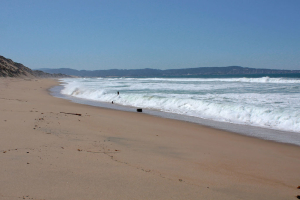
Monterey Bay, Northern California
Photo by Elery S. Oxford CC BY 2.0, via Wikimedia Commons
Susan and I come from Northern California, where the beaches are subjected to big forces. That coastline is exposed to that ocean, and that ocean is big, and the waves that hit it have been gathering momentum since the Gulf of Alaska. They effortlessly lift oil tankers out of their way as they pass under, and then continue building steam as they barrel southeast over a “fetch” of some fifteen hundred miles. What ends up hitting the headlands is explosive in its power, and thunderous in its tonnage. A good-sized one can be felt underfoot, and beaches on that coast can gain and lose a hundred horizontal feet between summer and winter. Susan and I have launched our ocean kayaks from charming pocket beaches nestled into bluffs, then returned a few months later to find a notch in the cliffs and a few cobblestones. And every beach is different. There’s a place south of Carmel called Monastery Beach where the face of the beach is so steep and so coarse that a kayak won’t stick to it. You have get in your kayak and get your paddle in your hands up on top of the crest, then shove off, ski down the berm, then launch through the surf. It’s a sporting proposition. And landing is even weirder.
A beach has body parts, but, as with any living thing, the body parts are always moving. There is a face that the waves run up, then a crest, which is overtopped only by the larger ones. There is a back beach which is largely flat, and that’s where the people lie around, or walk if they don’t want to dodge waves, and then behind that there will be another rise, sometimes called the storm beach, which is touched by waves only in the heaviest conditions. There the sand will dry out enough that wind becomes the shaping force instead of water, and grains are carried up and over small obstructions and drop into the dead air behind them, and embryonic dunes are created, and the dunes begin to grow and march inland. The underwater shallows and bars lead to the beach, which leads to the dunes, and all three act together to create a moving, shape-shifting rampart which protects the coast against heavy storms. As conditions change, the sand is exchanged freely between the elements of this triad. In stormy times, the beach is hit by rapid, back-to-back waves and the sand remains in suspension, getting no rest, until it is finally stripped away from the beach, creating bars and shallows just offshore, and those shallows cause the waves to break farther out, and blow their energy before hitting the coast. In really heavy conditions, like the storm surge that accompanies a hurricane, sand will get stripped even from the dunes, and carried back out to sea again. Then, when things are quieter, the beach is washed by smaller waves with longer periods between them, and the sand is carried back up and dropped and left, and the bars and shallows become beach again, and the beach heals and grows wider, and blows inland and replenishes the dunes. It’s a resilient system, and it is resilient because it’s responsive, constantly in motion. The reason it doesn’t break is because it bends. But it only works as long as it has a source of sand. Which brings us to longshore drift.
Longshore drift is what carries sand longwise up or down a coastline, and it is driven by the scalloping motion of waves angled slightly to the beach. This is what replenishes miles of beaches downshore from something like a river mouth. But sand is constantly leaving the system. It can hit a submarine canyon or a harbor mouth, or it can just get pulled out to sea beyond a depth called the depth of closure, where wave action no longer reaches it, and it is lost. If you have barriers at each end of a beach, say a headlands at one end and a canyon at the other, you are in a closed system called a littoral cell, and if your source of sand, whatever that is, does not keep up with the amount of it that leaves your cell daily, your beach is eroding, and you will lose it. It is called your sand budget, and every beach has one, and no beach gets to exceed it. Damming and pumping rivers can put a beach outside of its means. In our hometown of Monterey, California, the beaches are going away because the Salinas River is a ghost of its former self.

The demise of Tucker’s Island Lighthouse, Oct. 12, 1927
(Photo courtesy of NOAA)
All of this makes beach dynamics famously treacherous to tinker with. Many lives have been ruined when someone put a jetty or some other obstruction in the wrong place. In the very simplest scenario, everything downshore from the obstruction stops getting replenished by longshore drift and begins to erode, but it gets way more complicated than that. One time an entire island off the coast of New Jersey called Tucker’s Island just flat disappeared, and it was because they built a couple of jetties to try to save it. It was actually very sad—in the early nineteen hundreds it had a lighthouse, two hotels, guest cottages and a number of residences on it, all managed by a pioneering family of hardy souls, who some say had created the first beach resort in the U.S. But the island was eroding at its north end, so they built jetties across the inlet passage from it on the advice of an engineer from the University of Pennsylvania. It had the effect of reversing a critical current and making things worse, and longshore drift began stripping the island away in earnest. Three years later, the last structure to go was the lighthouse, and on October 12, 1927, it toppled into the sea. The lighthouse keeper photographed the whole thing on his Brownie box camera.
Here inside the Mesoamerican Barrier Reef, the source of our sand is almost entirely the reef. Some might come from outcrops or landslides, but for the most part creatures lived and died to give us this beautiful white sand. In fact, they probably lived and died and then passed through a whole chain of other creatures, so to a large extent you’re walking on fish poop, but don’t dwell on that. And that whole food pyramid is underpinned, as any food pyramid is, by those tireless primary producers, the photosynthesizers like the corals, the phytoplankton, the dune plants, the turtle grass, the coralline algaes—and the sargassum. It all gets broken down by micro-organisms and eaten by burrowing invertebrates, which is why we have shore birds working the surf zone and rays snuffling the sandy bottoms, noshing crustaceans and creating more sand. Some beaches require healthy rivers, and some require heavy surf pounding a headlands, but for us, it’s all about the reef. It is the reef ecosystem that creates our beaches. The reef is everything to us.
Sargassum is good for beaches in several ways, but sargassum does not become sand, at least not until you take an extremely long view of things. Sargassum has some mineral content, especially if it is encrusted by bryozoans, which most of it is (bryozoans can be pictured as tiny, filter-feeding creatures living in symmetrically-ranked glass condominiums—they’re another story), but that’s still not that much mineral content. Those piles of sargassum will not become same-sized piles of sand. But they will become organisms. They will fertilize plants and feed animals that become food for other animals, and as it all makes its way up the food chain, and the creatures have to protect themselves from herbivores and predators, they all start to employ a cute trick: They take calcium from the water around them, and the carbon that is the by-product of their own respiration, and they make calcium carbonate, CaCO3—it’s what every crab leg and coral frond is made of, and it’s what you are walking on when you stroll on the beautiful, powdered sugar beaches of somewhere like Tulum. In that sense, yes—sargassum becomes sand.
* * * *
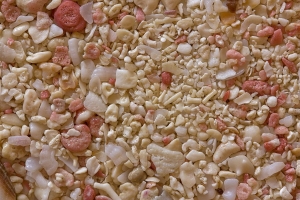
The creatures who lived and died: This coral beach in Bermuda is coarse enough that you can make out the organisms who comprise it.
Photo by Siim Sepp CC BY-SA 3.0, via Wikimedia Commons
The first debate we’re all hearing these days is about whether to rake the beaches. Raking the stuff up and carting it away is nice for us beachgoers, but questions are being raised about whether it is good for the beach. Texas A&M University did the only study I could find on beach raking, and I was surprised by the results. They monitored the elevation of several beaches on Galveston Island with surveying equipment, half of them raked and groomed in front of hotels, and half untended in less developed areas. They found no difference in beach elevation after a year. They issue a few caveats, to be sure. They point out that they measured only elevation, not horizontal width or beach slope. And a year isn’t very long. They’re calling for more studies. But, according to this early data, raking seems not to be a crime. But it is the second part of their study that paints the picture more broadly, and takes in that triad of bars, beaches and dunes.
In that part of the study they examined the effect of sargassum on dune plants, and those results were conclusive—there’s no doubt about it, dune plants like sargassum, or at least the subject of their study does, which is a common dune grass called bitter panicum (Panicum amarum). And it likes it whether you wash it to remove the salt or not, whether you leave it on top of the sand or mix it in—sargassum is just great fertilizer. The panicum grows bigger, and puts out more roots and stabilizes the dunes better. Panicum actually prefers the stuff unwashed, and the scientists speculate that that’s probably due to other important nutrients staying in the mix—plants are typically limited by the availability of nitrogen, phosphorus and potassium. It’s important to remember, though, that panicum is a dune plant, and is salt tolerant. For use in your garden you’d probably want to wash the stuff.
The scientists do point out that sargassum is good for the beach as well as the dunes—it creates food and habitat and protects the sand from both wave and wind erosion—but in the end, they seem to recommend raking the beach, but then carting the stuff no farther than the base of the dunes and piling it there, and then, periodically (it doesn’t have to be daily) spreading it more broadly across the dunes for the benefit of the plants there.
People are asking me if sargassum can be eaten. The answer is yes, but the reviews aren’t exactly glowing. EatTheWeeds.com calls it “not a prime edible, but a plentiful one.” But they do go on to offer several ideas for preparing it.
It has been suggested that we sell the sargassum. Various species of brown algae are already harvested and used in numerous things, including bio fuels, food thickeners, pharmaceuticals, cosmetics, and extracts for medical uses. There’s a whole industry out there (a couple of industry websites are here and here), and in fact they used to harvest sargassum live from the Sargasso Sea, and the practice was opposed by conservation organizations like the Sargasso Alliance, and was finally regulated in most U.S. waters. But what if they could gather it from beaches? Well, it still poses environmental problems. It would mean heavy equipment on the beaches where the turtles nest, and generally it involves collecting the stuff in dump trucks, where the load can end up being eighty percent sand and water by weight. Then you drive it away to process it somewhere else, and all the salt and sand ends up in landfills, and, according to most reports, the beach takes a beating. But the University of Alicante in Spain has designed a system that is transportable. A truck backs it onto your beach on a giant trailer, and the sargassum is put through a three-stage process right there, finally creating cleaned and dried bales of the stuff, all without leaving your beach. As far as I can tell, this system has only been designed—one has not been built yet.
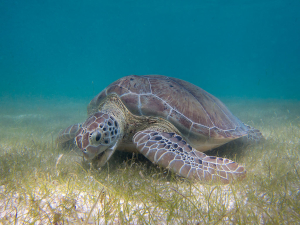
Green Sea Turtle (Chelonia mydas)
Photo by P.Lindgren CC BY-SA 3.0, via Wikimedia Commons
And, since they’re so close to everyone’s hearts around here including mine, I’ll close the article with a word about the turtles. I’m very sorry to report that sargassum does kill sea turtles. The Barbados Sea Turtle Project reports 42 dead, both greens (Chelonia mydas), which are endangered, and hawksbills (Eretmochelys imbricate), which are critically endangered. In 2014, the National Marine Fisheries Service reported 20 live and 23 dead green turtles stranded in the sargassum on U.S. beaches. The sargassum causes problems for them in several ways. First of all, when you swim among the turtles somewhere like the wonderful waters of Akumal Bay, they are so graceful and beautiful in the water that it’s easy to forget that they’re actually air breathers. They have to be able to get to the surface about every fifteen minutes, and a mat of sargassum pushed up against a coastline can get several feet thick, and if they cannot get up through it they will simply drown. Even if they reach the air, they might remain entangled, and end up beached and helpless in the mass of seaweed. It is also feared that nesting sea turtles will have trouble finding a clear patch of beach for a nesting site, and if their options are limited, they will get crowded together, and the result will be turtles digging up other turtles’ nests as they create their own. And then, of course, the hatchling has to get back through it all to reach the water, and that’s a trek which is already the most perilous sixty seconds of her life.
And that’s a life that might go on to span eight decades.
Now you know.
Sources:
http://treasureislandtx.org/TIMUD/Seaweed%20Report.pdf
–http://www.eattheweeds.com/sargassum-not-just-for-breakfast-any-more-2/
https://seaweedindustry.com/
http://news.algaeworld.org/
http://www.loopnewsbarbados.com/content/sea-turtles-victims-sargassum-seaweed
http://www.barbadosseaturtles.org/
http://www.sanpedrosun.com/environment/2015/08/08/sargassum-linked-to-dead-fish-washing-onshore/
https://sandiego.surfrider.org/wp-content/uploads/2010/01/DynamicsofBeachSand2007.pdf
http://www.houstonchronicle.com/neighborhood/bayarea/news/article/Groups-Seaweed-could-be-killing-sea-turtles-5585589.php
Tucker’s Island, By Gretchen F. Coyle and Deborah C. Whitcraft
The Journey of the Sargassum
There is a sea on the Planet Earth which has no shores. It is over two million square miles in size, and it is completely distinct from its surrounding waters both oceanographically and ecologically. It supports roughly a million tons of plant life, which provides habitat for over 100 species of fish and 140 species of invertebrates, and many of them occur nowhere else. All this teeming abundance is in waters that are so nutrient poor that visibility can be a couple hundred feet on a good day. If not for this astonishing ecosystem, in this astonishing sea without shores, this place would be an aquatic desert.
It’s called the Sargasso Sea. It is contained by a clockwise gyre of four different ocean currents that circle between North America, Europe and North Africa, and it is about 1,000 miles across at its widest point. Its sea level is three feet higher than the surrounding waters, and the waters are warmer and saltier. The foundation of the ecosystem is a remarkable seaweed called sargassum (Sargassum natans and Sargassum fluitans), a highly unusual marine algae that is completely pelagic (free drifting). It reproduces asexually through simple fragmentation, and it can do so easily, and anywhere it goes. Because it is pelagic, it does not have to compete for precious real estate on the ocean bottom, and it also is not limited to shallow coastal waters like the benthic (attached) seaweeds, which not only have to find some substrate to attach to, but then have to be able to grow up into some light so they can photosynthesize. Sargassum has none of those constraints, and it grows in great mats and windrows in a sprawling, mid-ocean world where the coastlines are hundreds of miles away and the bottom is sixteen thousand feet down. It consumes carbon and produces oxygen in huge quantities. It has been called the golden floating rainforest of the ocean.
Sail east from anywhere in the US or west from anywhere in Europe and you’ll probably have to cross it. Sailors have known about it for centuries, and it has broken some strong hearts when the seaweed was sighted from shipboard by early explorers, and they thought they were approaching land.
For myself, I started reading up on it because, though we’ve always gotten a little sargassum on our beaches around here, recently it’s been hitting us in huge quantities. It’s ugly. It’s slimy. It puts out hydrogen sulfide gas as it decomposes and it stinks. The tourists are not pleased. “WTF?” my friends are all asking me—but in that quaint way we older folks have of spelling things out completely.
* * * *
Well, I knew this would be a tough one and I was right. We’ve all read several articles in the popular press about this and none of them answer the question why, so I knew it wouldn’t be easy to find. A week into it I muttered to myself that it might have been easier if I’d been looking up the meaning of life. Then, on a whim, I did so. It’s 42. If you’ve read any Douglas Adams you already knew that. But anyway, bear with me, because I did arrive at what I consider to be an answer, and getting there was a pretty good trip, not just through the life cycle of one of the most interesting seaweeds in the world, but also the amazing Sargasso Sea, the world’s ocean currents, climate change, and agricultural and urban runoff as measured in continent-fulls.
It used to be thought that the Sargasso Sea was a one-way destination for sargassum seaweed. The model went like this: The sargassum grows in the north-west Gulf of Mexico (they’ve always gotten some on the Texas beaches), and that was thought to be sort of its nursery. Then the Gulf Stream current catches it and whips it around the southern tip of Florida and up the east coast of North America, and it settles out into the gyre that is the Sargasso Sea, and there the story ends.
The problem with that model is that it’s a one-way model—the sargassum goes in, and nothing comes out—and ecologists just hate one-way models. To any ecologist with a proper reverence for the Interconnectedness of Everything (capital ‘I’, capital ‘E’), if you’re looking at a one-way system, you’ve only found half the system. It wasn’t until last year that three Texas A&M scientists found what appears to me to be the other half. They developed a way to identify sargassum in satellite photos. If there is enough of it, it reflects wavelengths of light that jump right out at you if you use the right filter. Even if there is not enough to be directly visible, its presence breaks surface tension and dampens wave motion, creating what the scientists call a “slick” on the water. They started going through images, all the way back to the year 2000, which was the earliest year that the photos had enough resolution for this. What they found was that every year, a weather occurrence called the Azores High Pressure System creates strong south-bound winds, and they don’t exactly disrupt this huge North Atlantic Gyre—but they jail-break a bunch of sargassum out of it.
This expanded hugely the travels that we understood Sargassum to make. When it breaks out of the gyre, it drops down through three different passages between the island nations that border the Caribbean on the north—between Cuba and Haiti, between Dominican Republic and Puerto Rico, and between Saint Thomas and Anguilla the sargassum is blown through the passages, and it ends up in the Caribbean, where the North Equatorial Current grabs it and sweeps it west down the same gun barrel that brings us our hurricanes—right at the Yucatan. Then the Gulf Stream grabs it and carries it around the north-east tip of the Yucatan and into the Gulf of Mexico, where some of it continues around the south tip of Florida and up the East Coast again to complete the circuit, but a lot of it eddies backwards into the north-west Gulf of Mexico, where it reproduces wildly and buries the beaches in Texas.
They’re calling it the Sargassum Loop System, and it’s recent news, cutting edge science, and a pretty big discovery, but here’s why it doesn’t answer the question my neighbors are asking me: There seems to be nothing new about it. As far as the scientists can tell, sargassum has been travelling this circuit all along, and it had only resulted in occasional, and not very heavy, strandings of sargassum on our beaches.
But another study got my attention, and when you put the two together you have something.
In 2011, there was a huge episode of this, and in 2012 a scientist named Johnson and a couple of colleagues did a very clever thing. You see, scientists have software models of ocean currents. There is more than one, and people and institutions have worked hard on them, and they’re very detailed and sophisticated, and they do a pretty good job. And Johnson et al had historical data about where the heavy loads of sargassum were, and on what dates. So what they did, effectively, is they dropped some virtual sargassum in their software sea at a few of those places and dates, and then ran the tape backwards.
They were amazed at where it ended up. It wasn’t anywhere near the Caribbean, and it wasn’t anywhere near the Sargasso Sea. It wasn’t even anywhere near the Sargassum Loop System (which actually hadn’t been discovered yet). It was in a huge, elongated eddy that lies just above the equator and reaches all the way from South America to Africa. It’s called the North Equatorial Recirculation Region. While the huge Equatorial Current is taking everything west, this eddy forms above it, bounded on its north by a weak, usually seasonal current called the North Equatorial Counter Current. This explained why there had been landfalls not just here in the Caribbean, which has always gotten some sargassum, but also in places like Brazil, and even on the coast of Africa in places like Sierra Leone, where it had never been seen before and people didn’t know what in the heck they were looking at. And the thing about this eddy, this North Equatorial Recirculation Region, is that it’s swimming in nutrients. It’s west end is right at the mouth of the Amazon River. It also gets iron-rich dust blown over from Africa, and coastal upwelling off that coastline as well. According to their software models, the sargassum stayed there for a “considerable time,” and it just loved that place. It grew exponentially, moving in eddy-like motions and sucking up all that warmth and all those nutrients and creating masses and masses of itself—and then the counter-current broke down. The eddy vanished, the floodgates opened, and all that sargassum started across the Caribbean toward us.
It makes sense when you think about it, because the two biggest rivers in the Americas are the Mississippi and the Amazon. Which brings us to the subject of continental run-off.
I’ve written before about eutrophication, when I did a piece on jellyfish. It’s a word you’ll be hearing more of, unfortunately, as we pummel this planet harder and harder, and sure enough, it figures in this story too. Looked at simply, eutrophication is when excess nutrients wash into a body of water and mess everything up. The first thing that happens is an algae bloom, and that could be anything from phytoplankton to sargassum, and then as that stuff dies, the decomposition process robs the water of all its oxygen, and you end up with what marine biologists call a dead zone. This happens in big ways and small ones—I know divers who can swim down our barrier reef and tell you resort by resort whose septic systems aren’t working. But rivers like the Mississippi and the Amazon empty entire continents of their nutrients, and that now includes fertilizers, pesticides, industrial waste and discharge from sewage treatment plants. You can see the dead zones on Google Earth now. Look for the little dead fish icons. They’re courtesy of William and Mary College and the World Resources Institute (and thank you, Google, for being willing to display them!) The second biggest dead zone in the world is in a plume running west from the mouth of the Mississippi, which is why the sargassum grows so riotously in the north-west Gulf of Mexico, and man, if you think we’ve got problems, you should see the sargassum in Texas. They get it on a classic Texan scale. The piles on the beaches (called wracks) can be ten feet high there, especially around Galveston. When it comes in, they call it the golden tide.
And sargassum isn’t the only seaweed going nuts from eutrophication. On the Brittany coast in France, they got a green tide of sea lettuce (Ulva armoricana) in 2009 that off-gassed so much hydrogen sulfide that it killed a horse and rendered its rider unconscious. In 2011 it returned and killed thirty-six wild boars. The sensational press coverage left everyone with the impression that the seaweed was toxic (it’s not, but hydrogen sulfide is nothing to trifle with). The cause was clear: factory agriculture. Nutrients come in (in animal feed) but they don’t go out (no one returns the manure to sender), so there’s a gargantuan net increase in the nutrients in the Brittany area, and they end up in the ocean. Measures to curtail factory farming caused layoffs, closures and protests. The tourist industry there is 5 million dollars per year. The agriculture industry is 11.6. They’re still fighting.
In China, on the shores of the notoriously eutrophic Yellow Sea, the largest green tide ever recorded hit the beaches of Qingdao three weeks before the Olympics and its sailing regatta. The Chinese rose to it in impressive fashion: In just three weeks they removed a million tons of Ulva prolifera from the beaches in an operation that involved 10,000 people and cost thirty million dollars. Then they put up a boom to keep the stuff out that was thirty kilometers long.
* * * *
So, the picture that’s shaping up in the mind of this amateur naturalist looks something like this: The sargassum spends most of a year, or even more than a year, hanging out somewhere it has never been before, which is in the North Equatorial Recirculation Region, and it circles and blooms and circles and blooms. Then at some point, the countercurrent bounding it on the north dissipates, the eddying stops, and the sargassum floods out, rejoins the Sargassum Loop System and buries our beaches. But there’s a huge question still unanswered, which, of course, is this: How in the hell did sargassum start getting into the North Equatorial Recirculation Region? Nobody knows. Johnson and his team say that the causes “have not yet been elucidated,” but they suspect a link with global warming.
A voice in my head is going, I should have known. Climate change, and eutrophication. Both.
And they could both in theory be fixed, because the good news and the bad news here is that they’re both anthropogenic. Anthropogenic is a scientific term meaning caused by humans. But I prefer how the great Jimmy Buffet would put it:
It’s our own damn fault.
Now you know.
Sources:
-http://eol.org/pages/893154/overview
-http://precedings.nature.com/documents/1894/version/1/files/npre20081894-1.pdf
-http://research.tamu.edu/2015/04/21/app-uses-nasa-satellites-to-track-sargassum-along-texas-coastline/
-http://seas-forecast.com/
-http://mission-blue.org/2014/10/sargassum-inundates-the-beaches-of-the-caribbean/
-http://seas-forecast.com/Pages/stories/Papers/JeffFrazierthesisformatedforpublishingNEW.pdf
-http://www.readcube.com/articles/10.1038%2Fnature12860
-http://www.alertdiver.com/Sargassum-barometer-of-global-change
-http://www.usm.edu/gcrl/sargassum/docs/Sargassum.Invasion.of.the.Eastern.Caribbean.and.West.Africa.2011.pdf
-http://www.tandfonline.com/doi/abs/10.1080/2150704X.2013.796433#preview
-http://www.laht.com/article.asp?CategoryId=14091&ArticleId=2393072
Fission, Fusion and Spider Monkeys
Our neighbor, Ken, was relaxing on his sofa recently when a monkey opened his sliding screen door and walked in.
I once read a Dean Koontz horror novel that began exactly like that, and by the end of it things had not gone well, so I would have been feeling some trepidation, but Ken is a special effects guy and used to make movie monsters for a living, so I guess he’s pretty hard to rattle.
The monkey walked across the floor toward him, and since she was a spider monkey (Ateles Geoffroyi), this was an odd-looking sight. Spider monkeys have limbs so long that their hands almost brush the ground as they walk, and they also have a prehensile tail almost three feet long, so when they walk, they do not balance with their arms like other monkeys, they use their tail, swinging it back and forth in great arcs while their arms hang at their sides. Ken watched her approach like this, and she came right up to him, jumped up on the sofa where he was sitting, climbed into his lap and wrapped both arms, both legs and her tail around him, and that was pretty much where she stayed for the next four days as this remarkable yarn played out.
I have to say that for a guy who has created monsters who have destroyed more than one world, Ken is an extremely kind-hearted guy. He recognized immediately that he was looking at a very sad story. This monkey snoozing in his lap was not wild. And he’d actually met her before, at a neighbor’s house. She obviously was accustomed to people, not monkeys, and he noticed that her canine teeth had been removed, leaving her defenseless. This was a dumped pet. She was wandering the jungle all alone, hungry and clueless, and gravitating toward human habitations.
I have held a spider monkey, and I can tell you that when a spider monkey embraces you, you know you’re being embraced. It’s a strange sensation—their appendages are just so long, and so—well, numerous. They wrap around you every which way, and that tail turns up in the oddest places. They’re difficult creatures to put down, and Ken was discovering that when a spider monkey decides she likes you, you’re in a bit of a spot. She was attached to him everywhere he went—meals, bed, even the bathroom. She wouldn’t let go. Ken had been adopted.
The wondrous little creature was easy to fall in love with, but she was warm and loving only so long as she was getting her way, and she quickly started becoming a handful. He tried to put her out a couple of times, but she would start destroying his screens from the outside. If she didn’t get her way inside the house, she’d go in the kitchen and start breaking dishes. If he intervened he’d get slapped. Ken had a situation on his hands. He was getting his heart stolen and his kitchen remodeled at the same time.
He was making phone calls and firing off emails, and several neighbors were involved by now, trying to work out a solution for this poor monkey. The good news ended up being that there is a monkey rescue center in the Yucatan. It’s called The Jungle Place, and it was founded by a saintly couple named Heidi and Joel, who thought they were coming down here to retire. (You can read their story here.) The monkey is now lovingly cared for and carefully supervised as she learns how to associate with other monkeys instead of people, in a large complex of enclosures near Chemuyil.
Susan and I see spider monkeys around here so commonly that it’s easy to forget how blessed we are to have them around. They are the most endangered primate in the Americas (there’s another species of spider monkey in South America that is doing better). There are five subspecies of these spider monkeys (ours is the Yucatan spider monkey, ateles Geoffroyi yucatanensis), and no one has firm numbers on them all, but they’re getting pretty scarce. They need healthy, tall tropical forest and they need a lot of it. One group might need as much as a thousand acres, and they don’t like people. And they shouldn’t. They are hunted for food by some and captured for the pet trade by others, and anyone who’s not doing one of those two things might be wiping out their forest to build a resort. As the jungles get more and more fragmented by developments, their numbers are nose diving. But we have them here. And since here is a gated community of five-acre properties where we are forbidden by our own bylaws to clear more than five percent of our land, I’m hopeful that these monkeys will continue to find sanctuary among us.
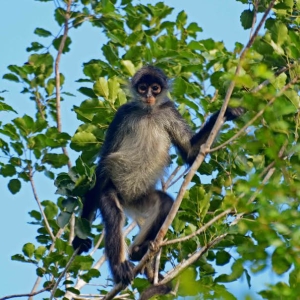
-
A Yucatan spider monkey (ateles geoffroyi yucatanensis) poses in a poisonwood tree. Photo by Jim Fossheim
I used to worry that our fairly modest dirt roads might impede their travels, but that was before I stood in the middle of one with my jaw on my chest as a monkey sailed across it, silhouetted against the sky, a hundred feet above me. It was like the road wasn’t even there. It was a display of confidence, faith, skill and beauty that you don’t very quickly forget. (Though I didn’t have a camera with me, our neighbor Jim is a little quicker on the uptake, and contributed the spectacular photo at the top of this article.) They spend a lot of time poking around in a lazy way, and during those periods they’ll be on the tops of the branches, but when they start to move in earnest they start swinging below them. Spider monkeys are second only to the gibbons in their mastery of this art. They can do forty horizontal feet in a single swing-and-leap. It’s a form of travel called brachiation, and it’s poetry to watch—a marriage of physics and five impossibly long limbs.
A group of spider monkeys can be as large as 100, though it is more commonly 20 to 30, but they are almost never seen all together. It’s a social structure called fission-fusion, and it’s pretty unusual. The main group breaks up into smaller sub-groups to go out foraging for the day, and if they don’t find much fruit, they will break up further to explore more possibilities. This keeps their demand on the fruit trees spread out across their huge territory, and reduces competition within the group. When fruit is plentiful, the subgroups will be larger. When it is not, they’ll be quite small, and you may even see solitary monkeys moving around. Even the sub-groups are fluid, and aren’t made up of the same individuals from one day to the next. The only associations with any persistence are between mother and child. And what’s really interesting about this fission-fusion social structure is that it is seen in only three primates: spider monkeys, chimpanzees—and us.
We often see a mother with a baby in the groups that cross our property. She carries the baby on her back, and they twine their tails together. Later on they will continue to travel together, and the mother will do things like pull two branches closer to each other to help the youngster make the leap. And they’re very human. They embrace after a period of separation, and they use gestures just like humans do. Our neighbor Tom saw a mother looking impatiently back at her child as the rest of the group was starting to move away. Finally, she reached back and thumped her own back, and the child obediently scampered up and climbed on board.
The subgroups are usually led by a female, who maps out the foraging route for the day. Sometimes a male will lead, but scientists say the females are better at it—they improvise more, and the troop ends up with a more varied diet. When Susan and I see them cross our property it is usually at the head of our driveway, and usually in a group of three or four (though as I was writing this, a group of seven or eight went by outside my window). They’re wonderful to watch, and we’ll stand there staring upward, but again, they don’t like people. When you bring one into focus in your binoculars, he’s invariably looking right at you. As he gets more agitated, he’ll start to bark like a dog. Finally, he’ll run out to the flimsy end of a branch and anchor himself by his tail while he uses all four limbs to vigorously shake the branches, and even throw some at you. (They are also known to pee and poop in your general direction, which is worth remembering.)
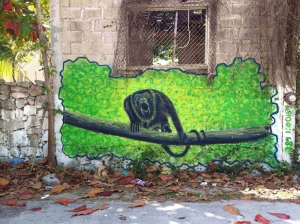
-
A remarkably accurate mural of a mantled howler monkey (Alouatta palliata) in Tulum. Photo by Randy Fry
They are among the most intelligent of the new world primates. They have twice the brain volume of the other prominent Central American monkey, which is the howler monkey. Scientists think they’re so smart because they are almost entirely fruit eaters (frugivores), so they rely on up to 150 species of trees and vines, and have to remember where they all are, and when they produce fruit.
And this whole old world versus new world thing is pretty interesting. When scientists say “new world primates,” they’re talking about the Americas. The “old world” primates in Africa and Asia, from whom we descended, are very different, and the differences open an interesting conversation about the evolutionary process. Old world and new world primates each have one key thing that the other doesn’t. In general:
Old world primates don’t have prehensile tails. This had always puzzled me, to be honest, because most of them are tree-dwelling creatures, at least in part, and we’re talking about an entire fifth limb, for heaven’s sake! It’s such a great innovation! I wish I’d invented it! It must confer a huge advantage! Why would it not evolve? Well, the difference lies in the forests. The forests in Central and South America are jungles, by the Webster definition—that is, they are extremely dense with very little open ground, lots of vines and climbing plants (they’re called liana), and a canopy that is completely unbroken. In these jungles, you can be entirely arboreal and never have to come to the ground unless you need something, like water. This is where spider monkeys live, and they stay high, way up in the upper canopy, and it’s why they look so funny when they try to walk. It’s just something that they never do, and aren’t built for.
Africa and Asia, by contrast, are teeming with large herbivores, which is something the Americas really don’t have. In the old world there are elephants, giraffes, and herds and herds of grazing animals, and they keep open areas in play. You may be a climber, but to live in this world, you also have to be able to get around on the ground. Tails can get in the way, and your climbing skills are less important. You have to be able to eat more than just fruit, too, and to do that, you have to compete on the savannas with some pretty fast and well-armed predators like lions and hyenas. This was what our ancestors faced. And the next paragraph has a lot to do with how we pulled it off:
New world monkeys don’t have opposable thumbs. Opposable thumbs make tool use possible, and tool use makes sophisticated cooperative hunting possible, and cooperative hunting makes it worthwhile for evolution to start increasing your intelligence, and that’s why you survived and are here today, and are able to read this article and think about these things. We are here because we outwitted the competition. Evolution didn’t give us intelligence for no reason. Intelligence is expensive. One fifth of our calorie intake goes to supporting our brains. Think about that—in a world where survival or extinction can turn on the slightest edge, that’s a huge chunk of our budget. Evolution doesn’t do such a thing unless there’s a payoff. The payoff was made possible by opposable thumbs. New world monkeys don’t have them, or, more accurately, they have lost them. They don’t need them and wouldn’t want them. They don’t need tools, because they have all the fruit they could ever want, and when you’re entirely arboreal, thumbs are in the way. You want your forelimbs to be nothing more than giant hooks. Thumbs might mess up those spectacularly beautiful leaps—and you don’t have to blow very many of those to remove yourself from the gene pool.
So those are the monkeys that surround us down here—intelligent, social, breathtaking in motion, and way too human. And I’ll leave you with one piece of trivia that’s probably more racy than you’re used to on this website. When you’re watching a group of spider monkeys pass by, the ones with the pink dangly things between their legs are not the males, they’re the females. I kid you not. The males’ penises retract completely and are seldom visible, but the females have the largest clitoris of any primate, and they’re always hanging out for everyone to see. They’re called hypertrophied, and they look for all the world like a penis—they even have a glans—but actually they’re only used for scent marking. As one Costa Rican rescue worker put it, human females have privates. Spider monkey females have publics.
Now you know.
Barracudas and Trans-sonic Jets
“Oh my God, he doesn’t see it…” Susan was saying to herself.
The thing about snorkeling is that you’re always looking down, instead of forward. But then I was twenty seconds away from learning several things about snorkeling that I hadn’t really thought much about before.
“Oh my God, he still doesn’t see it…” Susan said to herself.
In the best of times I’m not the most observant person in the world, but when I’m absorbed in the microcosm of a coral reef ecosystem, while floating on the surface, while looking down, while moving forward—well, I’m just pretty obtuse about what’s ahead of me, even by my own standards.
“…he’s really not seeing that thing, he’s really not seeing that thing…” Susan’s brain was repeating over and over, and here’s another thing about snorkeling: you can’t call out to each other. And that’s actually a pretty up-there handicap when you’re swimming around in the midway point of a food chain. Susan was going nuts twenty feet behind me. She was trying to raise my head through psychokinesis.
What I finally saw was the creature’s shadow on the bottom, about five feet below me. I saw the shadow looming down there, said to myself, “Hmmm,” looked up (finally), and he was three feet in front of my face, a great barracuda (Sphyraena barracuda). I was staring at his left flank and he was staring at me, and a sound track was playing in my head, and it was that low, rumbling drone they always play in the sci-fi movies when a giant spaceship is crawling across the screen, and here’s another thing about snorkeling: You can’t back up. Probably most people have never realized this or thought much about it, but you can’t back up when you’re wearing swim fins. Not really. Not meaningfully.
Not nearly damned fast enough.
I’m a rational person and a science writer, so I know that our memories tend to embellish moments like this one, and I also know that the interface between the air inside my mask and the water outside of it magnifies the images I see by up to thirty-three percent depending on a few things, so this barracuda was probably not really the size of a small submarine, but it sure seemed like it at the time. Let’s just say that he was way too big. Just a hell of a lot bigger than I needed for a predatory fish to be at that moment in my life.
So after I had successfully contorted myself around so I could swim away from this thing in a forward direction, and after I’d put a safe distance between me and it, and after I’d straightened my fins back out on my feet, and after Susan had finished laughing, which is what took the longest time and required her to come to the surface and remove her snorkel so that she didn’t die, I did what I usually do after a traumatic event: I looked up a bunch of stuff about it and published it here.
I learned that it is not actually that easy to get attacked by a great barracuda, but it can happen. The saving grace of my particular encounter was that I approached him, by dumb luck, from the side, and if you are stupid or unlucky enough to approach a large barracuda as closely as I did, that’s how you want to do it. Barracudas are like rocket ships. They are very long, very fast, very powerful, they can accelerate explosively—but they can only go in a straight line. They are built this way because they are ambush predators. Actually, their particular form of ambush predation is called ram feeding. They will hang out behind fronds of fan coral like a cop behind a billboard. They will cruise slowly around, watching, and when you encounter one you can feel that watchfulness. You get a very unscientific feeling in the pit of your stomach. Our diving friend Linda calls it “getting the eyeball.” And you feel that way for a reason. They are, in fact, visual predators, and they are carefully waiting for the right instant to explode forward in a predatory charge. They have resting periods when they’re pretty zonked out and you can approach them pretty closely, as I did, but you don’t want to do it from in front, because when they get startled the first thing they do is ignite the rockets.
They are among the fastest fish in the ocean, in short bursts. They can hit somewhere between twenty-seven and thirty-six miles per hour in a charge, depending on whom you listen to, and that’s remarkably fast for a thing that is completely submerged in water. I looked at that number, and looked at their unusual body shape, and decided to swing the wheel, and take a short detour into physics.
* * * *
There are three kinds of drag that might be experienced by a body moving through the water.
Wave drag is something the shipbuilders in Liverpool can talk about over pints all night, but which barracudas don’t care about because it only affects you if you’re traveling on the surface.
Viscous drag is the friction of the fluid against the surface of the object. One way barracudas keep that in check is with a layer of slime on their skin, but there’s something else they do that I noticed right off, but which I didn’t see mentioned anywhere in the literature (though I’m sure it’s out there): They are pretty close to cylindrical in cross-section. If you need to enclose a long, skinny space, a cylinder is how you do it with the minimum of surface area. I know this because I am an ocean kayaker, and the fastest ocean kayaks are pretty much shaped like phone poles. (This is unfortunate because a phone-pole-shaped kayak has very little opinion about whether it should be right-side-up or up-side-down.)

Wasp-waisted fighter jets: It’s all about the cross-sectional area. (Soviet Su-27 Flanker) Photo by US Dept of Defense, public domain
Then there is form drag. Form drag is the slowing you get when you have to push water out of your way, but it’s also the slowing you get when it has to fill in the spaces you leave behind you. Nature, after all, abhors a vacuum, so it’s best not to be dragging one around behind you all the time. Obviously, the best way to minimize all this is to be long and skinny and tapered at your rear end, which, in fact, is how fast fish, fast submarines and fast airplanes are all built, but it gets more interesting than that. Form drag can also happen midway down your body if your shape changes and that pushing-away and filling-in thing has to happen in smaller ways amidships, so fast fish will not only be skinny, they will also be very smooth and uniform for most of their body length. But here’s something even more interesting: fast fish can get away with some shape irregularities as long as their cross-sectional area stays about the same. A few hundred million years later, aeronautical engineers figured this out also. It’s called the Whitcomb Area Rule, and it becomes increasingly important as you approach the speed of sound. It’s why fighter jets have that funny, wasp-waisted look, to keep the wings from blowing out their cross-sectional area.
* * * *
Put it all together and you have a barracuda. Or, if you’re a fresh water person, you have the northern pike (Esox lucius). It’s a body shape called fusiform, but how they use that body is also interesting. It’s a swimming style called carangiform, in which only the rear-most one third of their body flexes when they swim. The whole forward part of them stays pretty much rigid, so that there is very little side-to-side waste in their motion. They have sacrificed maneuverability for speed.
Barracuda have that sinister look because of their under-bite and those wicked-looking teeth, and it’s not just show—you genuinely don’t want to tangle with those jaws. Those jaws were ingeniously designed by some evil evolutionary forces. They have a huge gape, and they have two sets of teeth on each jaw, a row on the outside that is small, flat and razor-sharp, and right inside of it, a row of dagger-like things that plunge into sockets in the opposing jaw. The result is that the barracuda can make a flash decision to “ram” a prey fish without caring very much how big it is. The big teeth pierce the fish and hold it, and anything sticking out the sides gets neatly amputated by the row of little razor-sharp ones. Divers report them using a “three strikes” technique—they hit the fish in the middle, then return twice more for the head and the tail. They can kill prey as large as themselves.
Attacks on humans are rare, and accidental, but the thing to remember in the ocean is that accidents happen. For one thing, they will strike anything that glitters, so it’s best to leave your baubles and bangles at home. I don’t even wear my wedding ring, lest I pull a Frodo Baggins and lose both my ring and the finger it had been on. Another reason things can get messy between swimmers and barracuda is that they are also scavengers. This is true of a lot of predators we consider to be proud and noble, including the bald eagle and the wolf. Being willing to eat carrion or scavenge others’ kills will actually get you out of a lot of pinches, and few species are beyond it. So barracuda will follow large predators, hoping to grab some of the pieces if someone gets nailed, and this gives them the unnerving habit of following us around as we swim. Spear fishing among barracuda can get especially dicey.
Susan and I actually see the smaller, one- to two-foot barracudas fairly commonly when we swim around here. Like almost all the fishes in the Caribbean, the juveniles find shelter in the mangrove roots, the sea grass beds and the coral reefs—all the places Susan and I like to swim. The big adults are more about the open water.
A Bad Day on the Yucatan
I picture a dinosaur standing on the coast of what would become the Yucatan Peninsula. I always picture a brontosaurus, I’m not sure why, and in my mind’s eye she cranes her long neck back over her shoulder to the south-east, and up toward the sky. The gleaming object that has captured her attention is actually seven and a half miles across and is made of rock that is fifteen percent denser than the rock she is standing on, but all she sees is a gleam because it is travelling at 44,640 miles per hour and is surrounded by a shock layer that has been brought to incandescence by compression wave heating and is now at 35,500 degrees Fahrenheit, and is so bright that it is getting a little bit painful to look at. She is a brachiopod, so her encephalization quotient, which is the ratio of body size to brain size, is only 0.1. She’s not the brightest bulb in the Yucatan even by dinosaur standards, but I picture her having a very uneasy feeling about this.
The object passes over her in complete silence, being well over two hundred thousand feet above her, and in the next several seconds, as she tracks it with her tiny head and long, long neck, it burns through ever denser atmosphere, getting more and more brilliant as it plummets to the northwest, and then, at a spot fifty miles out to sea from where she is standing, it impacts.
There is a flash roughly as bright as the surface of the sun, and a reflective dome appears to rise into the sky above it and then dissipate. The sea is pulverized into a miasma along the horizon beneath it. But still she hears nothing. A widening cone of shattered rock and water rises skyward, upward and outward, in slow motion. Still there is silence, but a shimmering layer of air at ground level appears to be getting taller, and that’s because it’s getting closer—it is the leading edge of a ring-shaped blast wave moving outward at 16,700 miles per hour (I worked all this out). She gazes at its approach for long moments, and still there is only silence. It takes 10.8 seconds for the blast wave to reach her, but even then what finally hits her could not really be called sound, because sound travels at only one twentieth that speed, and besides, when this thing hits her, she does not hear or feel a thing. The impact kills her instantly, and then the heat sears the flesh from her bones.
The Gulf of Mexico is 1,500 feet deep where this great meteorite hits, which sounds like a lot of water, but it’s only one twenty-sixth the diameter of this rock. To put that another way, as its leading surface strikes the sea, its trailing surface is still at an elevation of 40,000 feet. The ocean is a mere puddle, almost inconsequential to this impact event.
The temperature at the impact site hits fourteen thousand degrees Fahrenheit, and everything within a 1,000 mile radius is immediately incinerated just by the flash. One hundred and ten cubic miles of rock is melted into a sheet three miles thick. Forests are flattened in a radial pattern out to 6,200 miles. The rock thrown skyward in the widening ejecta cone hits twenty-five thousand miles per hour in its ascent, and a lot of it ends up in orbit. Some of it even achieves escape velocity and is never seen by the planet Earth again. Some of it is on the moon today.
After the initial flash, super-heated winds race outward from the impact site at up to 2,000 miles per hour, and more forests are ignited. An earthquake of somewhere between magnitude 10 and 12, depending on who you talk to—which are magnitudes never experienced in recorded history—rocks the planet all the way from northern Canada to the mid-latitudes of South America. Oceanographic events that have been called “mega-tsunamis” hit the coasts of what are now Mexico, Texas, Alabama and Lousiana, and they are 300 feet high, but scientists figure we got off easy because the meteorite did not have much water to work with. If it had hit in deep water, the height of those waves might have been two to three miles. The ejecta that did not achieve orbit begins to fall back to earth pretty quickly, and fiery rocks rain down across the western hemisphere for hours after the impact, igniting more forests. It is the cretaceous period (actually, it is the last day of the cretaceous period), and oxygen levels in the cretaceous period were high—30 to 35 percent, as opposed to today’s 21 percent. The forests flash easily into flame, and the firestorms race in sheets across the landscape, but the inferno is limited, so far, to the Americas.
Then the orbiting rocks begin to re-enter the atmosphere.
Unlike the earlier events, the meteor shower is world-wide. The meteors, so recently blasted up into Earth orbit, start to rain down as if the sky is burning, in such numbers that they not only start spot fires everywhere they hit, but they also heat the atmosphere itself, to the point that surface temperatures reach several hundred degrees, and whole forests flash spontaneously into flame. Soot, smoke and the dust of the original explosion rise in great towers and plumes into the upper atmosphere. The sea floor of the Gulf of Mexico is now circling the globe at two hundred thousand feet. The occlusion is complete—zero light is reaching the earth. For up to two months you cannot see your hand in front of your face, and for up to a year photosynthesis is impossible world-wide. Whole food chains collapse, on a continental scale. Temperatures plummet and previously balmy areas freeze over. This “impact winter” would last about ten years, but even that isn’t the end of things.
The reason that isn’t the end of things is that those fires have also released as much carbon dioxide as three thousand years of fossil fuel burning. In addition, the carbonate and evaporite rocks of the Yucatan get vaporized by the explosion into yet more carbon dioxide, and Yucatan rock also contains a lot of sulfur, and that gets blown into the upper atmosphere as sulfur dioxide, then combines with water to create sulfuric acid. It will fall a few years later as acid rain, but in the meantime, the droplets reflect away the sunlight, contributing further to the darkening of the earth. All told, ten trillion tons of carbon dioxide, one hundred billion tons of methane gas (which, by the way, is a much more powerful greenhouse gas than carbon dioxide) and one trillion tons of carbon monoxide end up in the upper atmosphere. So as the Earth recovers from the explosion, then from the fire storms, then from the wash of acid rain, and climbs painfully, over a period of ten years, out of the dark and freezing impact winter, it is only to enter a period of global warming that would last not decades, but centuries.
What’s amazing is that anything survived.
* * * *
Sixty-five million years later, give or take a couple, it was the late 1970’s, and a guy named Walter Alvarez was poking around near the town of Gubbio in Italy. He was a geologist, and what he was studying in Italy was the tectonics of the Mediterranean region, but what he kept wondering was a little off-topic. Why, he kept asking himself, is there this layer of unique clay exactly at the boundary of the cretaceous and the tertiary periods? The cretaceous-tertiary, or “KT,” boundary is, after all, a fairly auspicious moment in Earth’s history—it’s when the dinosaurs died. It was one of the most important extinction events in the history of life. (It was not the biggest—that was the Great Oxygen Catastrophe that gave us the air we breathe.) It had been suggested by a few lonely voices that the KT extinction might have been created by an asteroid impact, but it was a pretty fringe theory. Two geologists named Kelly and Dachille had noted in 1953 that something had hit the Earth back then hard enough to slightly alter its axis of rotation. But theories don’t go far in the scientific community until they’re backed up. Especially over-dramatic theories involving global catastrophes. No one was paying much attention. But Walter Alvarez couldn’t leave it alone. He was just sure this layer of clay held the key.
He did what I used to do when something was bugging the hell out of me: he called his dad.
* * * *
Luis Alvarez was a Nobel prize-winning physicist. He did things with people like Enrico Fermi and Robert Oppenheimer that I can’t even explain to you, including discovering whole new families of particles, but he was one of those guys who was too gifted to be constrained by his own profession, so he did a lot of work in other fields, especially during World War II. He invented “Friend or Foe” radar beacons, which are now on just about every aircraft in the world and are called transponders. (He held the patent for it, and signed it over to the government for one dollar.) He also developed ground controlled approach, or GCA, making it possible to land aircraft in low-visibility conditions, which was a pretty big game-changer in WWII. And, like most men of our fathers’ wartime generation, his work had its dark side. He invented explosive lenses. He worked out a way to keep enemy submarines from knowing they’d been found by microwave radar. And, inevitably, he ended up on the Manhattan Project, developing the atomic bomb.
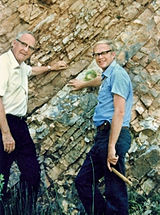
-
Luis and Walter Alvarez at the KT Boundary Photo courtesy of Lawrence Berkeley Laboratory, public domain
It was a brilliance that ran in the family. He descended from a long line of gifted people. His grandfather was a physician who did breakthrough work in Hawaii on leprosy. His great aunt Mabel was an impressionist painter. His great uncle Walter was a founder of the Mayo Clinic. And now his son was a little over a year away from becoming famous.
But it was physics the senior Alvarez brought to bear when his son put the KT extinction problem in front of him. The first thing the two of them decided to find out was how long it had taken for that layer of clay to get deposited. Fortunately, there’s a very convenient clock in the geological record, and it’s called iridium. Iridium is an element that almost does not exist in the Earth’s crust because it’s very heavy, and it all sank to the Earth’s core early in the planet’s history. But it exists in great quantities in all the rocks in outer space, which means in comets and asteroids, which means in all the shooting stars that burn up in our skies all the time. There is a constant light drizzle of iridium sifting down onto our earth’s surface from outer space all year, every year, and it’s quite steady and predictable. You can tell how long a layer of strata was sitting there exposed to the sky by measuring the amount of iridium in it. When they ran a sample of the KT clay, they were expecting to find that it had taken about ten thousand years to get laid down. The number that came back was four million. They were flabbergasted. There was no way that half-inch layer of clay had taken that long to get laid down. But there was another obvious explanation for all that iridium:
It was from an asteroid that impacted the earth.

-
Mabel Alvarez
See page for author [Public domain], via Wikimedia Commons
Now they were really interested. They roped in two colleagues of Luis’s, nuclear chemists Frank Asaro and Helen Michel. Together, they used a technique called neutron activation analysis to identify the concentrations of all the elements in the clay. They found that the extra-terrestrial quantities of iridium were only the beginning of the revelations. The clay also contained minerals like glassy spherules, shocked quartz and micro diamonds, all of which are only created under horrific amounts of heat and pressure. And they also ran some numbers on the soot. Taken world-wide—and this layer did seem to exist world-wide—that layer of clay contained enough soot to suggest that the “entire terrestrial biosphere burned.” In layman’s terms: every plant on earth.
In 1980 they published a paper, and the shouting commenced. Some think that one reason that this debate was even more acrimonious than most was that there had not been a single paleontologist involved in this discovery. They had all been scooped by a geologist and his physicist dad. But then scientists never take major shifts like this one quietly, and shouldn’t. Arguing is what we pay our scientists for. That’s part of scientific rigor. It’s what distinguishes science from religion. They argued for a decade. What finally happened was someone found the crater.
* * * *
Actually, the crater had been found two decades earlier, it just hadn’t been announced. The data had been sitting somewhere in the archives of Pemex, Mexico’s state-owned oil company, since the 1960’s, in the form of a “gravity map,” which maps the densities of underground rock by looking at gravitational anomalies.
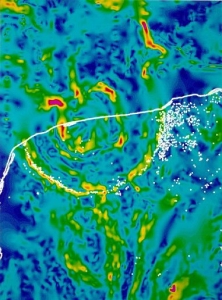
-
Chicxulub Crater Gravity Map
The white dots are cenotes created by the impact. The white line is the coastline.
By Milan Studio.Milan studio at en.wikipedia. [Public domain], from Wikimedia Commons
The problem is that oil companies, for obvious reasons, consider their discoveries proprietary, and keep them secret.
A Pemex person named Glen Penfield stumbled across the crater again in 1978 while doing a magnetic survey of the region. He saw the arc of the crater, and laid his hands on the gravity map, and another map of the peninsula itself, and lined up the two maps. The two arcs connected perfectly. They created a great circle, half under the ocean and half under the peninsula, with the small coastal town of Chicxulub near its center. That’s next to Progreso, where the cruise ships come in, 150 miles northwest of Susan and I.
To his credit, Glen Penfield argued to make the information public, and to Pemex’s credit, they finally did allow him to present it without specifics at a conference of the Society of Exploration Geophysicists in 1981. But the talk was lightly attended because, ironically, most of the experts on impact craters were at another conference that was scheduled for the same time—a conference on impact craters. Penfield’s presentation was barely noticed. He went back to work.
The funny thing is that at almost the same time that Penfield had been presenting, a grad student named Alan Hildebrand had gotten interested in finding this crater, and was out there soliciting information on “candidate craters.” But he and Penfield did not connect until nine years later when a Houston Chronicle reporter with one of those amazing reporter’s memories hooked them up. Finally, in 1991, the dots had been connected. They had their crater.
The senior Alvarez had passed away three years before.
* * * *
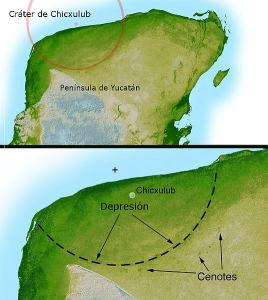
-
The Chicxulub Crater
By Yucatan_chix_crater.jpg: NASA/JPL-Caltech, modified by David Fuchs at en.wikipedia derivative work: Mircalla22 (Yucatan_chix_crater.jpg) [Public domain], via Wikimedia Commons
Seventy percent of species on the planet, both plant and animal, perished in this event or in the period following it. All the dinosaurs went extinct except the ones who became birds. This is a fun thing to reflect on: when you look at a cute and pretty songbird in your garden, you’re looking at the only dinosaur tough enough to survive the most horrific event in the planet’s history.
Not that evolution thinks or plans ahead, but for what it’s worth, there are great lessons in who survived and who did not. Anything large that was walking on dry land bit the dust. For them, there was just nowhere to hide. The largest vertebrates to survive were the crocodiles, for reasons that still serve them well today (they are largely unchanged): they are semi-aquatic, so they had somewhere to hunker during the worst of it. They are cold-blooded and can go long periods without food. They can get by on detritus and carrion, and they lay their eggs underground.
The same general principles applied to the creatures in the oceans. The large, surface-dwelling creatures perished, but farther down in the water column, and on the bottom, things went better, as those organisms rely more on carrion and detritus, which did not immediately vanish.
Specialists, for the most part, all went extinct. Pure predators who needed a steady supply of living prey all perished. Similarly, pure herbivores also had a rough time finding a plant for about a decade, and they all disappeared. But the generalists and opportunists who could change their habits in a pinch—those are the ones who survived.
One of them was a group of small, shrew-like, hair-covered, burrowing creatures. They were called mammals.
And that’s interesting to reflect on too. Not only did that tweety-bird in your garden survive the most hideous catastrophe imaginable—but so did you.
Now you know.
Finding the Monarchs
The entomological discovery of the century was made on January 2nd, 1975 by a textile engineer with no college degree. His name was Kenneth Brugger, and his proudest professional accomplishment was inventing no-shrink underwear, which truly is a pretty proud accomplishment in my book—but he will be remembered for something far greater.
The story begins almost four decades earlier. It was 1937, and two Canadian zoologists named Fred and Norah Urquhart were obsessed with solving a mystery that had stumped scientists for over a century. In five words, here’s what the mystery was:
Where do the monarchs go?
All summer they dance and weave in abundance above the plains and hills of the United States and southern Canada. They drop into our backyards and flit around our roadsides. There are millions and millions of them. But then in the fall, they vanish, and in the spring they return. And no one could figure out where they went.
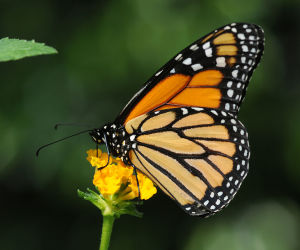
-
Monarch Butterfly (Danaus plexippus)
Thomas Bresson CC 2.0, via Wikimedia Commons
Scientists knew that they were migrating. They even knew that they were overwintering somewhere in congregations, because that’s what the ones west of the Rocky Mountains do, at sites in coastal California like our old stomping grounds, the Monterey Peninsula. But the ones east of the Rockies just vanished. Every year a whole continent’s worth of butterflies disappeared. Somewhere out there, over a billion monarch butterflies were congregating together for the winter.
And nobody could find them.
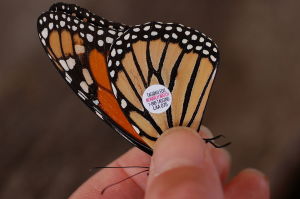
-
Tagged Monarch
Photo by Derek Ramsey[GFDL 1.2], via Wikimedia CommonsThe Urquharts started by attacking a fairly tricky problem no one had solved yet: How to tag a monarch butterfly. They only weigh about as much as a paper clip, and effortless flight means everything to them. How do you tag such a creature? They traveled to the Monterey Peninsula, and tested tagging methods on the overwintering population there in Pacific Grove. They endured several years of failures, and finally succeeded with a tiny self-adhesive dot-shaped label placed on the underside of the hind wing. They started tagging. After several years of grinding away at this themselves, they took it to the next level, and started recruiting volunteers, launching what today would be called a “citizen science” project. Hundreds of butterfly lovers and school children tagged thousands of butterflies every year—and they had to tag them every year, because monarchs don’t live longer than that. In that sense this was an unrelenting project they’d gotten themselves into—after seven or eight months every animal you’ve tagged is dead, and you have to start over. But they and the volunteer troops kept persevering, and the data started trickling in. The monarchs began coming back to them in the mail, some dead, some alive and lovingly packed among wildflowers in perforated boxes. They got letters. They got phone calls. One tagged monarch alighted on a golf ball an instant before the golfer smacked both of them to kingdom come. He mailed the body in. They started sticking pins in a great map. The years went by, and the flight paths began to materialize. The lines were all converging toward Texas. It was looking like a run for the border.
They started placing ads in Mexican newspapers. In 1972 Kenneth Brugger picked one of them up.
* * * *
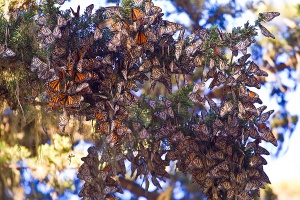
-
Monarchs Overwintering in Pacific Grove (a tagged individual is visible in upper center)
Photo by Agunther (Own work) CC 3.0, via Wikimedia Commons
Kenneth had gone through a divorce and re-crafted his life. He had quit his job working for the Jockey underwear company in Kenosha, Wisconsin, and moved to Mexico City as a textile consultant. And when he read the ad, a memory came back to him. He remembered driving once through the high elevations of the Sierra Madre mountains and suddenly finding himself inside a great cloud of monarch butterflies. He wrote the Urquharts. I think I can help, he said.
He had struck up with a Mexican woman named Catalina Aguado. He was 53 and she was 21, and she shared his love of nature. Together they began spending their weekends roaming the Sierra Madres looking for the butterflies. They had a Winnebago, and they would hike through the days and sleep in the RV. They were in frequent contact with the Urquharts, who encouraged them and advised them. They were seeing tantalizing signs—a transient cloud here, a roadside littered with bodies there. The signs were pointing toward Michoacan state. They talked with locals. They continued looking. In 1974 they got married.
The moment finally came when they were climbing a peak called Cerro Pelon. They ascended past the 10,000 foot level and crossed a clearing toward a stand of oyamel fir trees, and when they drew close they realized that every tree was cloaked in monarch butterflies. I picture them both standing speechless. The butterflies hung in festoons from every bough, they covered every trunk, they carpeted the ground, and clouds of them danced through the air in front of their faces. Fred Urquhart remembers getting the call. “We have located the colony!” Kenneth said. “We have found them—millions of monarchs—in evergreens beside a mountain clearing.”
I am certain that that scene was, to Kenneth Brugger, a spectacle of breathtaking beauty which he never forgot, but actually, the orange of the butterflies was not something he could see. He was completely colorblind.
* * * *

-
Monarch Butterfly Biosphere Reserve
By Luis Avalos (Own work) [CC BY-SA 3.0], via Wikimedia Commons
Really, Kenneth Brugger solved two mysteries. Indigenous peoples in those mountains like the Purepecha, the Otomi and the Mazahua knew all about those monarch colonies. In fact, they revered them. The monarchs were part of their folklore and their spirituality. They rang the church bells when the monarchs arrived, usually around the Day of the Dead, and they considered them to be the souls of their ancestors. They knew all about those butterflies, but they didn’t talk about it much to outsiders. And they didn’t know where in the heck they disappeared to in the spring.
They all got their lives changed by this discovery. They now live in the middle of a World Heritage Site called the Monarch Butterfly Biosphere Reserve, amid throngs of tourists.
* * * *
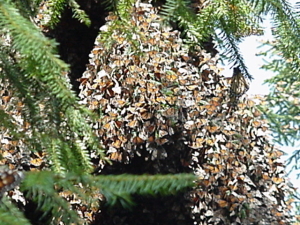
-
Monarchs at the Monarch Butterfly Biosphere Reserve in Michoacan, Mexico
By Bfpage at en.wikipedia [Public domain], from Wikimedia Commons
The monarchs cannot overwinter just anywhere. They’re extremely particular. The area must have trees to roost in, whose foliage and canopy protects them from direct snow and wind. It must be close to freezing, so that their metabolisms slow and they don’t use up the reserves they will need for the return flight. But it cannot be too cold, or they will have to turn on the furnace to keep from freezing to death, and that uses up reserves too. There must be underbrush for safety, because when they fall to the ground, which happens a lot when it’s close to freezing and you’re in a stupor, it is usually too cold for them to fly back up to escape predators like mice, but they can crawl up into the understory. It must have streams or some other water source to drink from, and it also must have fog, again to keep them hydrated, because they can only fly to the water source during warm hours on warm days, and they must return to the roosting tree before it gets too cold to fly, and they get very jumpy about that. Sometimes you can watch an entire cloud of monarchs rise from a water source all at once and return to the trees, just because a cloud has passed in front of the sun.
In Mexico, all these requirements limit them to just a dozen small oyamel forests in the Sierra Madres, which occur on a few mountain tops, above 10,000 feet, and facing southwest. So there is great concern about the deforestation that is happening, due to illegal logging. But let me mention here that the locals who do that are subsistence farmers living on communally-owned “ejito” land and have been relying for generations on these forests for lumber and firewood. It’s up in the United States that monarch habitat is being wiped out systematically by huge corporations, and it’s a much more dire problem. More on that in a bit.
* * * *
As spring approaches and the days get longer and warmer they begin to get restless, and clouds of them fill the air. The males pursue the females up into the sky and grapple with them, pulling them in long, fluttering paths to the ground, where they mate, remaining attached for up to an hour. They have not eaten since they arrived in the fall, and they have a long journey ahead of them. Mated females begin leaving first, usually the second week of March, and it has to be timed perfectly. If they leave before the milkweed has sprung up in the U.S. and Canada, the cycle will fail, because they have to lay their eggs on milkweed. Nothing else will work for the caterpillars when they hatch.
The females make it about halfway up the United States, laying eggs in milkweed patches all along the way, and then they die. The males don’t make it as far. They start dropping right away. Unromantic fact: Evolution doesn’t usually knock itself out prolonging the life of a male who has already mated. We become superfluous. (In some cases we become a protein source for the female, but monarchs don’t do that.)
The eggs hatch and within five weeks there is a new wave of monarchs, and they fly north, continuing the migration. This generation might make it as far as southern Canada, and again, they are laying eggs on milkweed patches as they pass, sending new waves of monarchs into the skies across the North American landscapes. There will be a couple more generations like this through the summer, and finally the whole continent is repopulated, shimmering and glinting with monarchs again, and then something interesting happens. When the very last generation emerges from their chrysalises in late August or early September, they have developed differently. Their wings are slightly larger. The veins in their wings are thicker. Their bodies are heavier and can store more fat. They will live for seven or eight months instead of a few weeks. Their sexual maturation has been put on hold. These butterflies are not about mating, they are about flying. That’s because the trip south is not a multi-generational affair like the trip north was. They’re in this for the long haul. For some of them it will be over three thousand miles—then they must survive the winter, then they must fly most of the way back. These are the elite athletes, the ultra-marathoners. These are the super-butterflies.
And the amazing thing is that these are the great-great-grandchildren of the butterflies who left the Sierra Madres. Not a single butterfly in this migration has ever flown the route before. And they’re going to find a small grove of trees thousands of miles away in the middle of a mountain range they’ve never seen. Scientists haven’t cracked that one yet. No one knows how they do it.
They only fly during the day. They roost in trees at night, at what are called waystations, in smaller congregations than the final one, but still a delight to behold. As they move south and converge toward the border, the ribbons of butterflies in the sky thicken and broaden, and there are places in Texas where the sight can take your breath away.
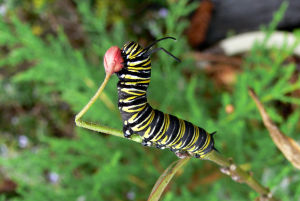
-
Monarch Caterpillar
Photo by Linda Tanner, [CC BY 2.0], via Wikimedia Commons
They don’t have many predators. One reason for their fondness for milkweed is that it contains chemicals called cardenolides, which are steroids that taste nasty and arrest your heart, and the caterpillars not only eat it without getting poisoned, but they proceed to co-opt the chemical, and put it to use in their own systems as a defense against predation, and it persists into the adult butterflies. Both caterpillar and butterfly have bold markings that are considered warning coloration. The viceroy butterfly (Limenitis archippus ) looks almost identical to the monarch, and I was taught growing up that it was a case of Batesian mimicry, and the viceroy was getting a free pass while not really being toxic himself. But there is now evidence that the viceroy is even more toxic than the monarch, which actually makes it a case of Mullerian mimicry, in which both species are dangerous, and have found it advantageous to advertise that fact with the same signals.
Here’s the bad news: In 1996 a little over a billion butterflies overwintered in Mexico. In 2013 there were thirty-three million. That’s a drop of 97%. According to a non-profit called Journey North, there is a whole range of causes, including the deforestation I mentioned, a series of unfortunate climatic events, ordinary loss of habitat due to development, and even ecotourism isn’t helping. But the problem that really frosts me is the one about the milkweed, because that’s one which, at least in theory, we could fix if we wanted to. Here’s what’s going on:
There are 115 species of milkweed, and the monarchs can use any of them. They grow like weeds in a variety of habitats from swampy to arid, and they do well on roadsides, field sides and other disturbed areas. You’d think there would be worse plants to hitch your wagon to. But what happened to the monarchs is genetically modified crops.
There are now genetically modified corn and soy bean strains in wide use which are resistant to an herbicide called glyphosate (you know it by its brand name, Round-Up). This allows the agriculture industry to spray it liberally on their fields, where it neatly kills everything but the crops. The problem is, the vast majority of monarch habitat had been in the sprawling farmlands of America, especially the corn belt. It was between the rows of crops, around the edges of fields, hugging the fence posts, in odd corners behind sheds and structures—milkweed is one of those plants that pops up in any unused space in the agrarian landscape. And according to Monarch Watch, the Midwest monarch habitat is “virtually gone,” with 80 million acres lost in recent years. Dr. Chip Taylor remains upbeat. “Numbers are really down,” he says, “but the monarchs will come back.” And I’m glad Monarch Watch has an optimistic director. We need optimists.
If you want to help, you can plant a monarch garden. Monarch Watch can set you up with a monarch garden kit, and show you how to plant your own little monarch waystation habitat with milkweed for the caterpillars and all the right wildflowers for the adults.
* * * *
It seems like way too many of my articles have a sad ending. But I believe in looking at the joy when we can, and the story of finding the monarchs is a captivating and uplifting drama. It was many years ago now. Of the four players in the tale, only Catalina is still with us, but all of them will be remembered. So that’s the image I’ll leave you with: Catalina Aguado and Kenneth Brugger walking out into a high-altitude clearing in the Sierra Madres, and staring in stunned silence at millions and millions of beautiful monarch butterflies.
Now you know.
When Squids Fly
In this article I’m going to not tell you about cuttlefish.
We had dinner with Dave, Nancy and their daughter Sidney last night, here on our Caribbean coastline in Mexico, and all of us were remarking on the cuttlefish we’d been seeing out on the reef lately. Cuttlefish are beautiful and enchanting little creatures, about nine inches long, with graceful tentacles hanging from their face, huge, mesmerizing eyes with W-shaped pupils, and an apron-like fin all the way around their body that undulates like a dust ruffle to propel them around. They’re inquisitive, and whenever Susan and I come across a few, they will usually stay with us for a while as we swim. Caribbean reefs are just full of beautiful and mysterious creatures, but Susan and I were becoming especially fond of these cuttlefish.
The specific question that had been intriguing Dave was why they always seem to occur in threes. Susan and I had noticed this too. You’ll see them in ones and twos now and then, but usually threes. Fascinating. I started digging. What I learned was just amazing. Here’s what I found out:
Cuttlefish don’t occur in the Caribbean.
“D’oh!” I said to my laptop monitor, and smeared my hand down my face. It shows you how much I still have to learn about my new ecosystem.
No one’s sure why they don’t occur in the Caribbean. Cuttlefish have one of the strangest distributions you can imagine. They’re in the Atlantic and they’re in the Pacific—it’s not like they’re not in our oceans. They’re on the European coastlines and the African coastlines and the Asian coastlines and even the Australian coastlines, but they do not touch the Americas. The best guess is that they evolved in the old world, and then the big oceans got too cold and deep for them to cross, being warm water and shallow water creatures. There’s a part of me that’s somewhat surprised that they haven’t managed to get introduced somehow, and start throwing things out of whack like the lionfish is doing.
What we’ve been looking at is called the Caribbean reef squid (Sepioteuthis sepioidea), and they look a lot like a cuttlefish—in fact, their scientific name alludes to the resemblance (cuttlefish being the order Sepiida).
Well, they may not be cuttlefish, but they are cephalopods, and cephalopods are my second-favorite mind-blowing organisms after jellyfish, so Dave, don’t be disappointed yet. Trust me, Caribbean reef squids are fall-down-and-slap-the-ground amazing. For one thing, they can fly. More on that in a bit.
Cephalopods are the octopi, squid, cuttlefish and nautiluses. They are a mash-up of legacy evolutionary traits and astonishing innovations not seen anywhere else. They’re shellfish (mollusks) who took a bizarre evolutionary turn, and I hugely enjoy bizarre evolutionary turns, because they remind us that life on this planet is not following any grand scheme, and neither are we. (We became us by accident too, believe me—and by the way, we only made it by the skins of our teeth.)
Cephalopods can change color in a flash, by conscious control, using muscular contraction and pigment cells called chromatophores. Their colors shimmer and dance across their bodies as you watch. They can also change their texture instantaneously, going from silky smooth to rough and spiky in a blink, and they can change their shape to mimic other creatures or objects. All that remains of their shell (ignoring the nautilus for now) is a beak a lot like a parrot beak, which is dead center between their tentacles (actually called arms) which they use to crunch the shells of their prey. A large species of octopus can have roughly the intelligence of a dog or a cat, depending on who you talk to, and squids and cuttlefish have been studied less, but appear not to be far behind.
That intelligence level is not bad for a shellfish, and it fascinates scientists, because their brains and nervous systems are so radically different from our own, or from any mammal, or even bird or reptile. They are such different creatures that in many ways intelligence in cephalopods can be considered a case of convergent evolution. That’s where two species independently arrive at a similar solution to a problem. Two thirds of their neurons are not even in the brain, but are out in the arms, which have a lot of autonomy in what they do. It is not a centralized system like ours, and if you watch an octopus forage in a rocky reef, you’ll see this design at work—they are reaching into numerous crevices and hidey-holes simultaneously. Clearly they’re thinking about eight things at once.
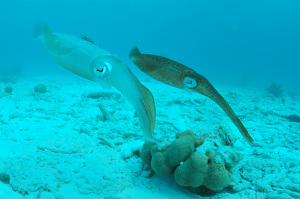
-
Two Caribbean Reef Squids (in different moods)
Photo by Clark Anderson CC BY-SA 2.5
You can put a crab in a jar, and an octopus will figure out how to unscrew the lid and get it out. You can put the octopus in the jar, and he’ll figure out how to open it from the inside. I don’t know if they’ve tried any of this with a squid or a cuttlefish. An octopus named Otto in the Sea Star Aquarium in Coburg, Germany, got annoyed at the 2,000-watt spotlight that was left on all night above his tank, so he started hitting that thing with jets of water and shorting the place out. I’m not making this up. It threw the aquarium into crisis. Everything went down including the pumps, and it threatened the lives of all the creatures in all the tanks, and it happened every night. They had to stake the place out to figure out what the hell was going on. Otto had other quirks: He was fond of doing something a lot like juggling with the hermit crabs in his tank. He would periodically rearrange everything in it (including the hermit crabs), and he liked to damage the glass by smacking it with rocks. There are other stories from other aquariums. They are talented escape artists, and will leave their tank at night to help themselves to dinner in the crab exhibit, returning to their own tank to eat, and then hiding the remains.
But the thing is, they don’t live long. Sophisticated and intelligent though they are, one or two years is all you get if you’re a cephalopod. It’s called being semelparous—they die immediately after they reproduce, and there’s not a thing you can do about it, and I remember this causing a lot of wet eyes around the Monterey Bay Aquarium from time to time when I was a docent there. These creatures are aware, and they have personalities, and attachments get formed—and then they die.
* * * *
In 2001, Sylvia Macia and her husband Michael Robinson, both marine biologists, were in a boat off Jamaica when a Caribbean reef squid burst out of the water with its fins flared outward and its arms held in a radial pattern, and it sailed to a height of six feet above the water over the course of a thirty-foot flight before dropping back in. They were flabbergasted. Flying fish do this (family Exocoetidae), and it’s a cute trick for predator evasion. There’s no better way to befuddle your pursuer than to blast through a reflective ceiling and vanish. But squid? There had been a few rumors and folk tales, but hell, the ocean is just full of rumors and folk tales. Thor Heyerdahl, who has (and deserves) some respect, reported squid occasionally falling on his raft Kon Tiki. And now and then a biologist will find a squid dead on the floor next to his tank. But those kinds of jumping mishaps can happen with any fish, including a goldfish. This thing was flying.
They sent out a signal to the mollusk community. Reports started trickling in. Maybe this had been witnessed before, but people had assumed they were looking at flying fish. I mean, let’s face it, a flying squid is just not something that has a cubbyhole in your brain. But Macia and Robinson were marine biologists. They knew what a Caribbean reef squid was. Aware of the possibility now, scientists began paying attention with new eyes. The sightings continued to mount. But they were all anecdotal. There were no photographs. There was no proof. The sightings seemed to be very rare, and the flights are so brief, and squid are nocturnal, and catching a flight on film was looking like it might be impossible. They published a paper anyway, in 2004. It was well received. But they still had no proof.
Then, in 2009, a retired geologist named Bob Hulse was on a cruise ship off Brazil. He was an amateur photographer, and he was packing a wildlife camera a lot like Susan’s. He was shooting in burst mode, and at a high resolution, and he captured a handful of “unusual creatures” flying above the water. Though it was not his field of science, he was observant enough to know that he was seeing something weird. He forwarded the shots to the University of Hawaii, and they forwarded them to a scientist named Ronald O’Dor, now at Dalhousie University in Halifax, Canada, and that’s who started working with the best and, at the time, only photographic documentation of flying squid. (They have since been photographed off Japan.) He knew the data he was looking at was gold. The exact interval between the frames was known, and he could calculate the velocity and the acceleration, and get a close look at the body parts. He lit into the project.
What O’Dor is piecing together is amazing. Cephalopods already have the jet propulsion thing dialed in. That was known. They jet around underwater, and blast away backwards as an escape technique. They fill their body (mantle) with water and force it out under great pressure through an organ by their mouth called a funnel. The funnel can be directed, like the nozzle of a guided missle, so they have control. They extend their fins, and hold their arms out stiffly to create another flight surface, and they rocket through the air like little cruise missiles, trailing exhaust streams of water and steering with their flight surfaces. Gliding is too tame a word for what they do. They have a propulsion system onboard, and they have aerodynamic control.
This is breaking science (he presented his paper in 2012), so there is still lots of argument, but O’Dor now believes that they do not fly to escape predators—they do it to travel long distances. They do it to escape the drag of the water. He believes that it explains some long migrations that had always seemed implausible. Using Hulse’s photographs, he calculated that they get five times the speed in the air that he had ever measured in the water from the same propulsive effort. They fly. They fly to get around. But we never knew they did it, because they do it at night, when the birds aren’t out.
Six species of flying squid have now been identified.
The Caribbean reef squid was the first.
* * * *
The Caribbean reef squid communicate with each other through color. Over forty distinct patterns of color and shape have been identified, and that’s just for communication. There are looks scientists call bars, belly stripes, dark arms, yellow flecked, speckled belly. When they’re pissed off, their brow ridge turns metallic gold. They layer the artwork, like imaging programmers do. There will be a background, and then one or more patterns or shapes overlaid on top of it. Scientists have modeled the whole thing in Photoshop, and given them names. They can flash one message to a squid on their right, and a different one to a squid on their left. The courtship display is a shimmering, moving background overlaid with zebra stripes. Some scientists are arguing that they have both a vocabulary and a syntax, and that that constitutes language. But only a few are saying that. Language in animals is controversial. It takes cojones to use the L-word in the scientific community.
They can imitate anything. When they flee into open water they become pale. When they flee into the coral they become rough-textured and brown. When they’re stalking prey they can make themselves look like sargassum seaweed. They can become a parrotfish by swimming backwards, holding their arms out like a tail and displaying eyespots on their rears. Like all cephalopods, they can shoot out a cloud of ink to confuse a predator, and sometimes they’ll do this and then real quick make themselves look like an ink cloud next to the ink cloud.
They are very social. They hang out in schools called shoals, and there is a hierarchical social structure, based mostly on size. The shoal will have sentinels around its perimeter, all facing outward in different directions. If a predator needs to be distracted or confused, one of the larger squid will rise to the challenge. Mixed schools have been observed, with other species of squid present, and there is an association with two species of goatfish, who will forage on the bottom beneath the shoal of squid, protected by their vigilance, but it’s not clear what if anything the squid get out of it.
The young hide in the turtle grass beds, and the older ones like to shoal in the open water, and here, Dave, I’m circling back to your question. When they come into a reef, it’s usually to mate. To get the girl, a male must intimidate and out-display other males, and these face-offs will be going on in the coral, always in the presence of a female. Two plus one makes three. I’ll bet that’s what we’re seeing.
In the end, the winner approaches the girl. At first she flashes an alarm pattern at him, but he persists, comforting her by blowing water across her, jetting away briefly, and then returning, in his shimmering, zebra-striped splendor. This might go on for an hour. Finally, when she has succumbed to his charms, he displays a special pulsating pattern and attaches a sticky packet of sperm called a spermatophore to her side, and leaves.
So in the end, it is she who performs the sexual selection for the species, choosing whether to use the spermatophore. She can place it herself into her sexual organ, called a spermatangia–or she can discard it. If she has deemed the male to be worthy of continuing his evolutionary journey, the next thing she does is find a place to lay her eggs. Then she dies. She never meets her children.
Now you know.

